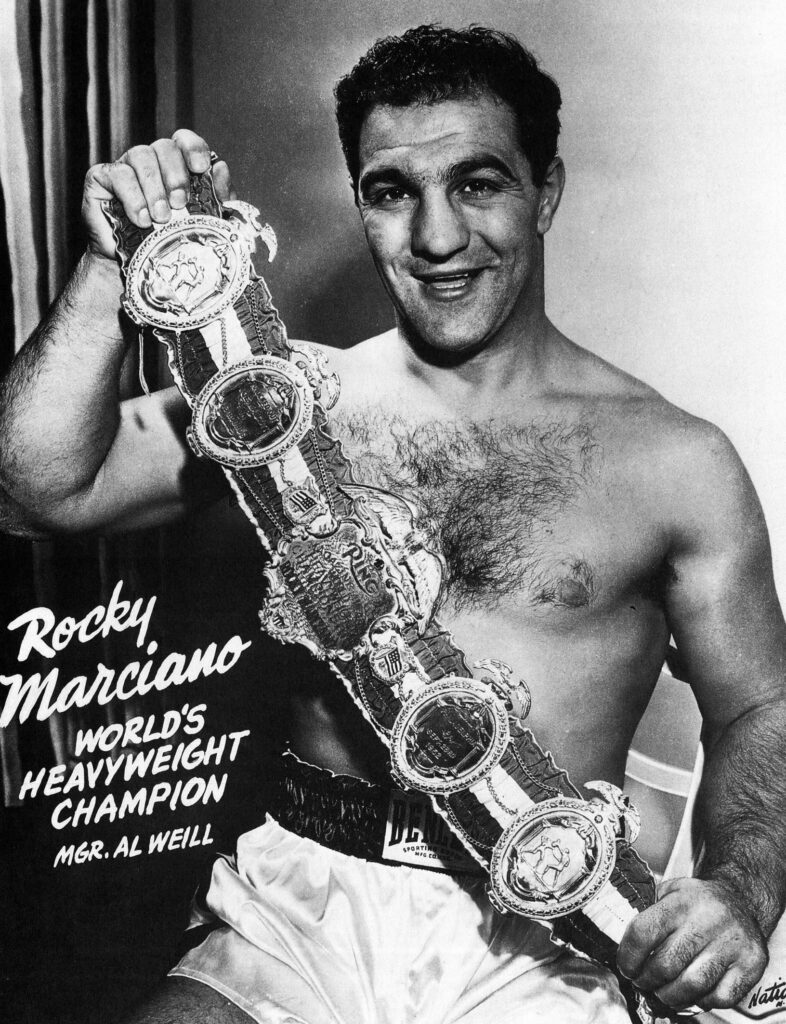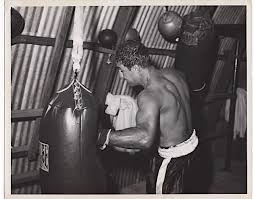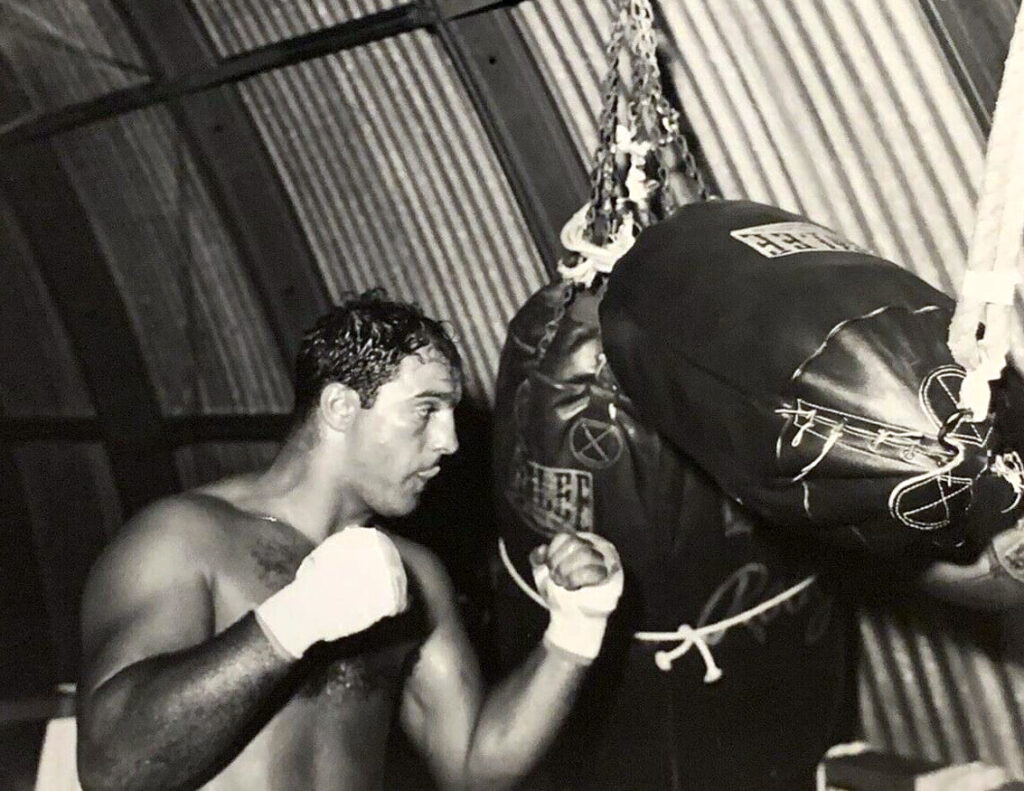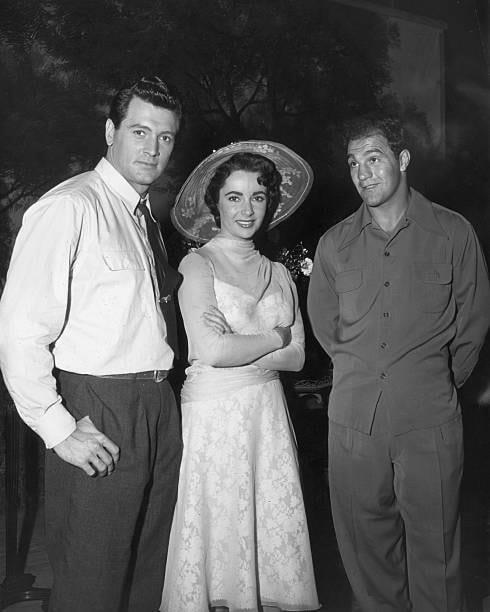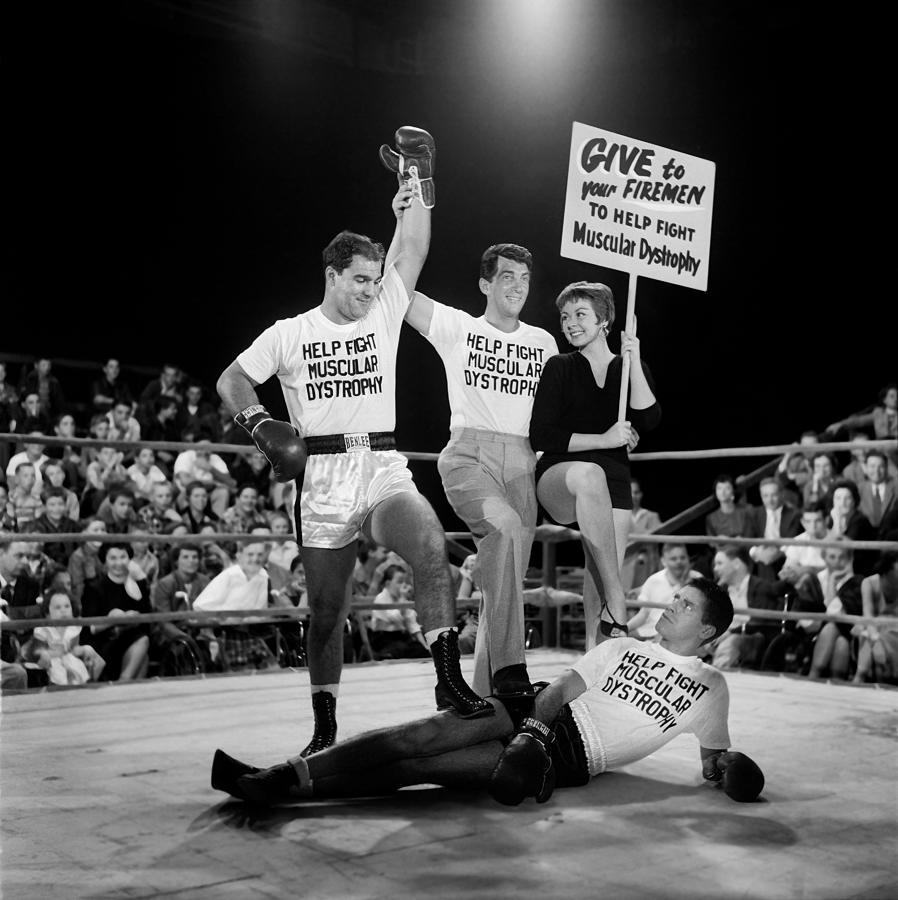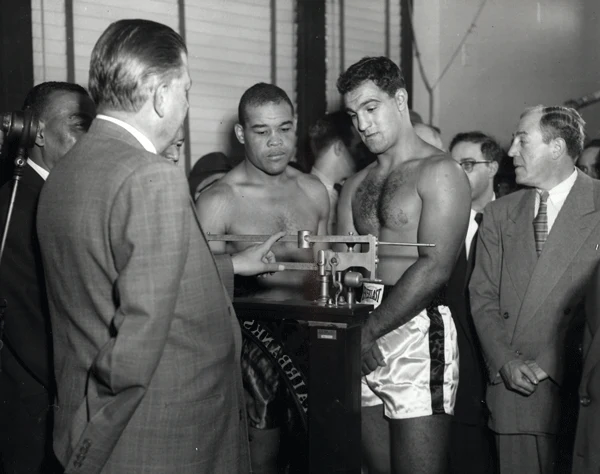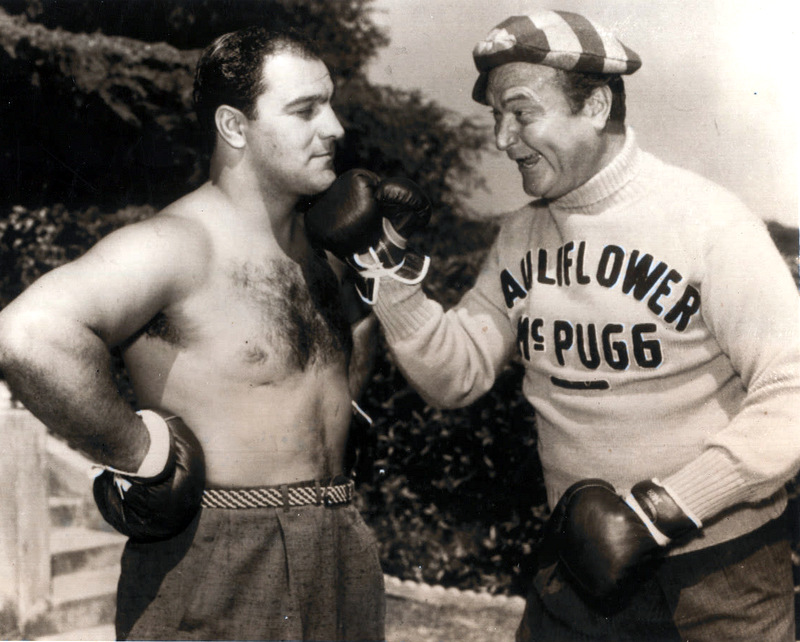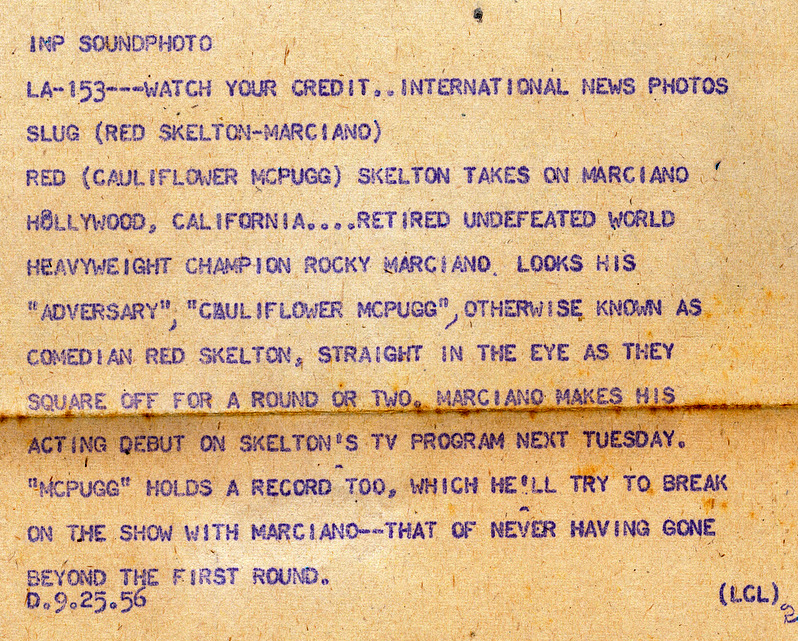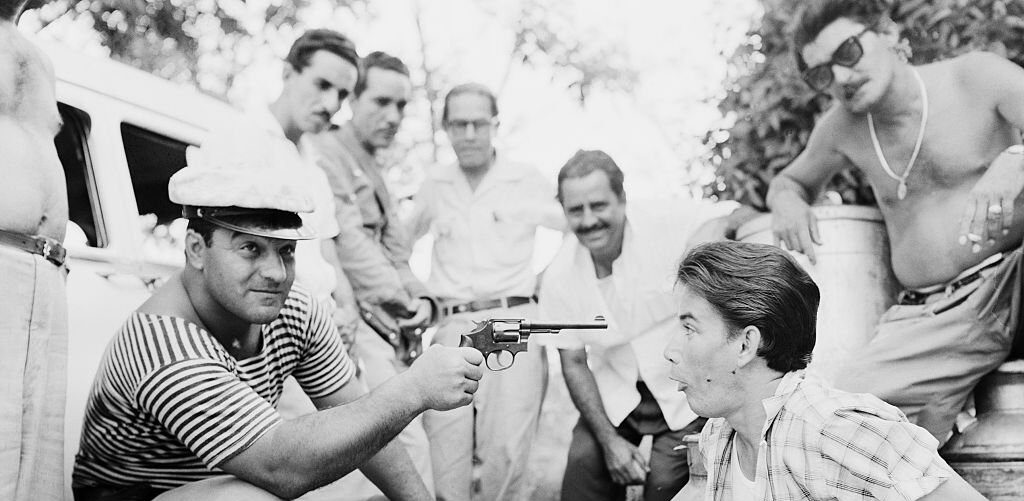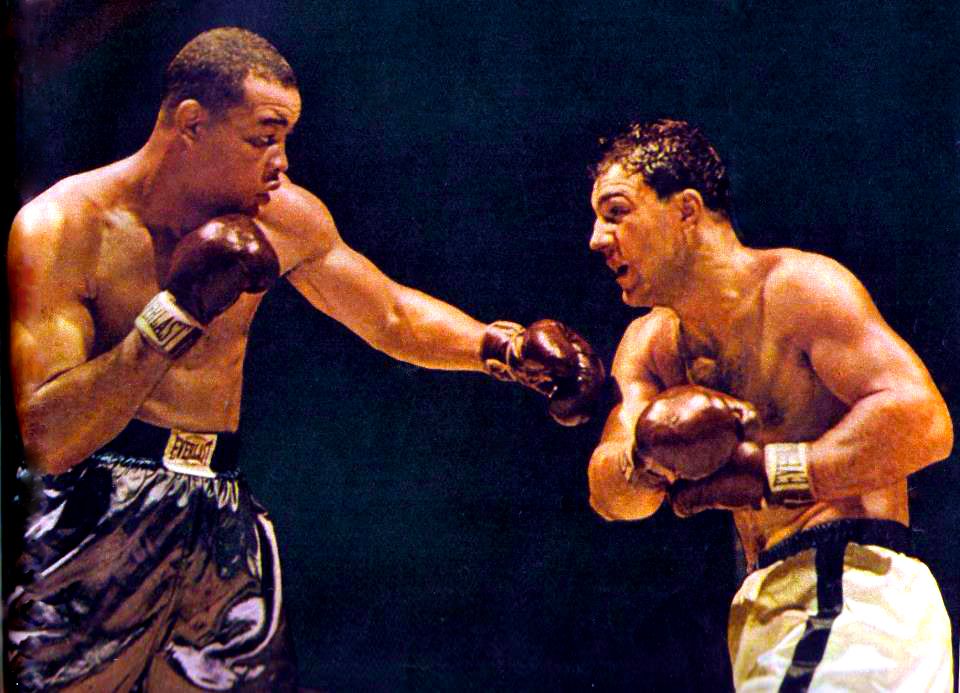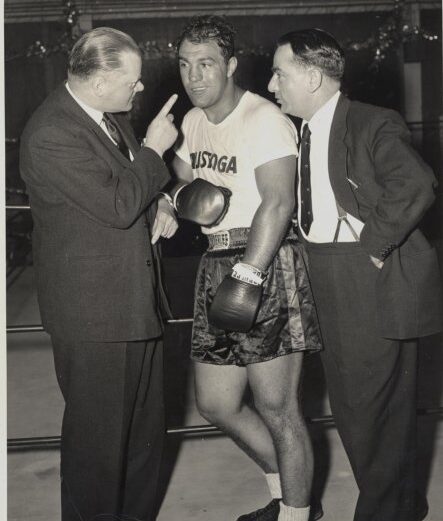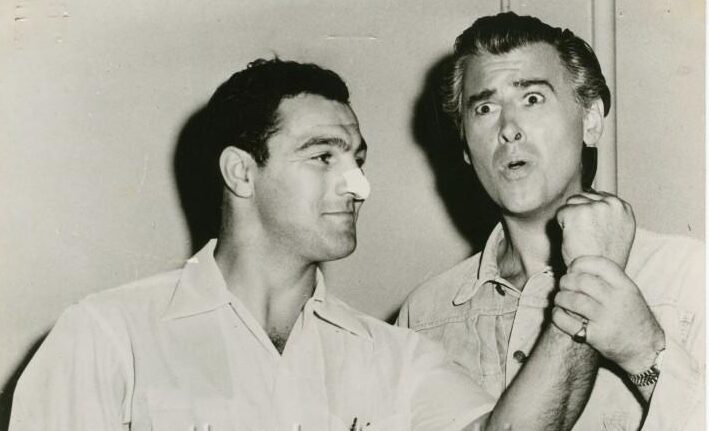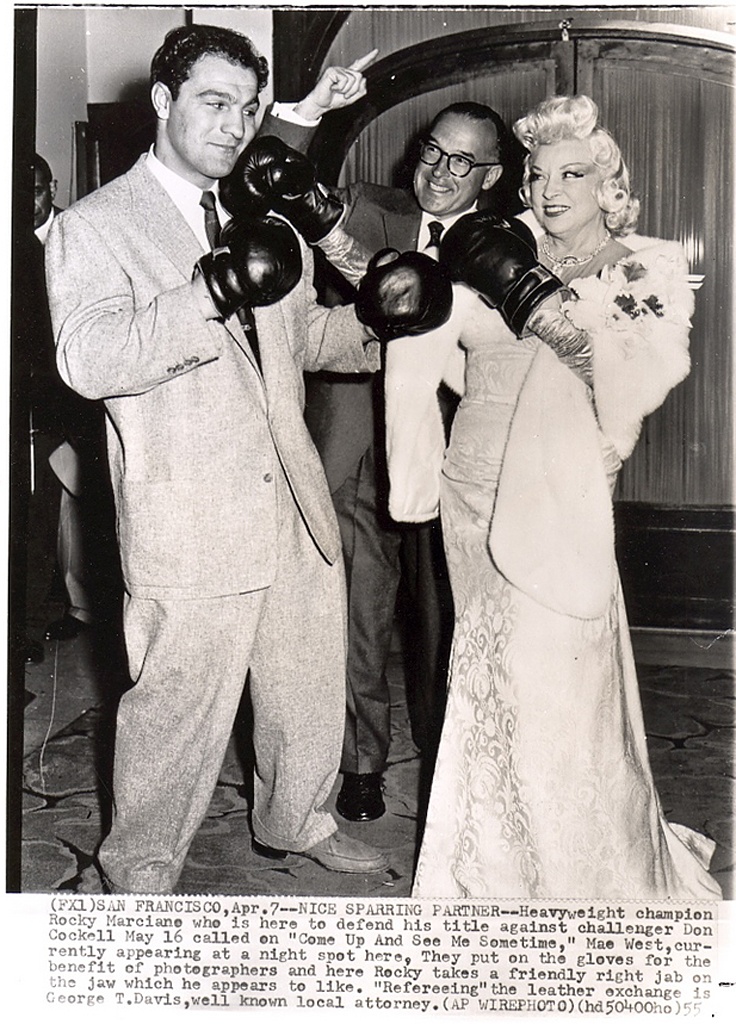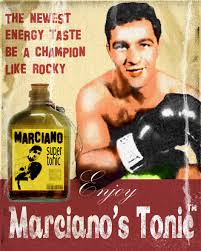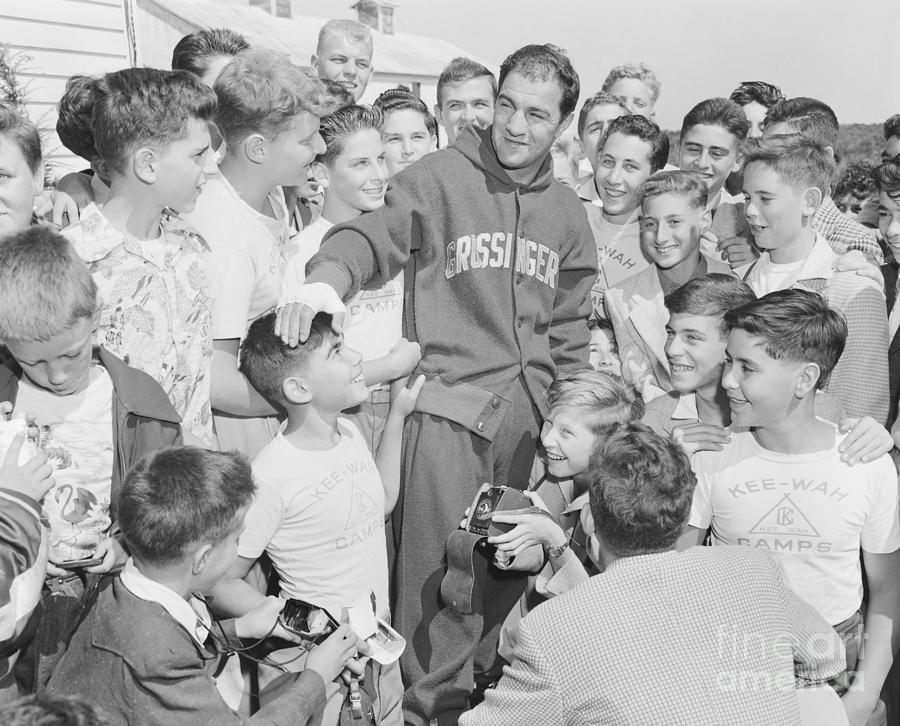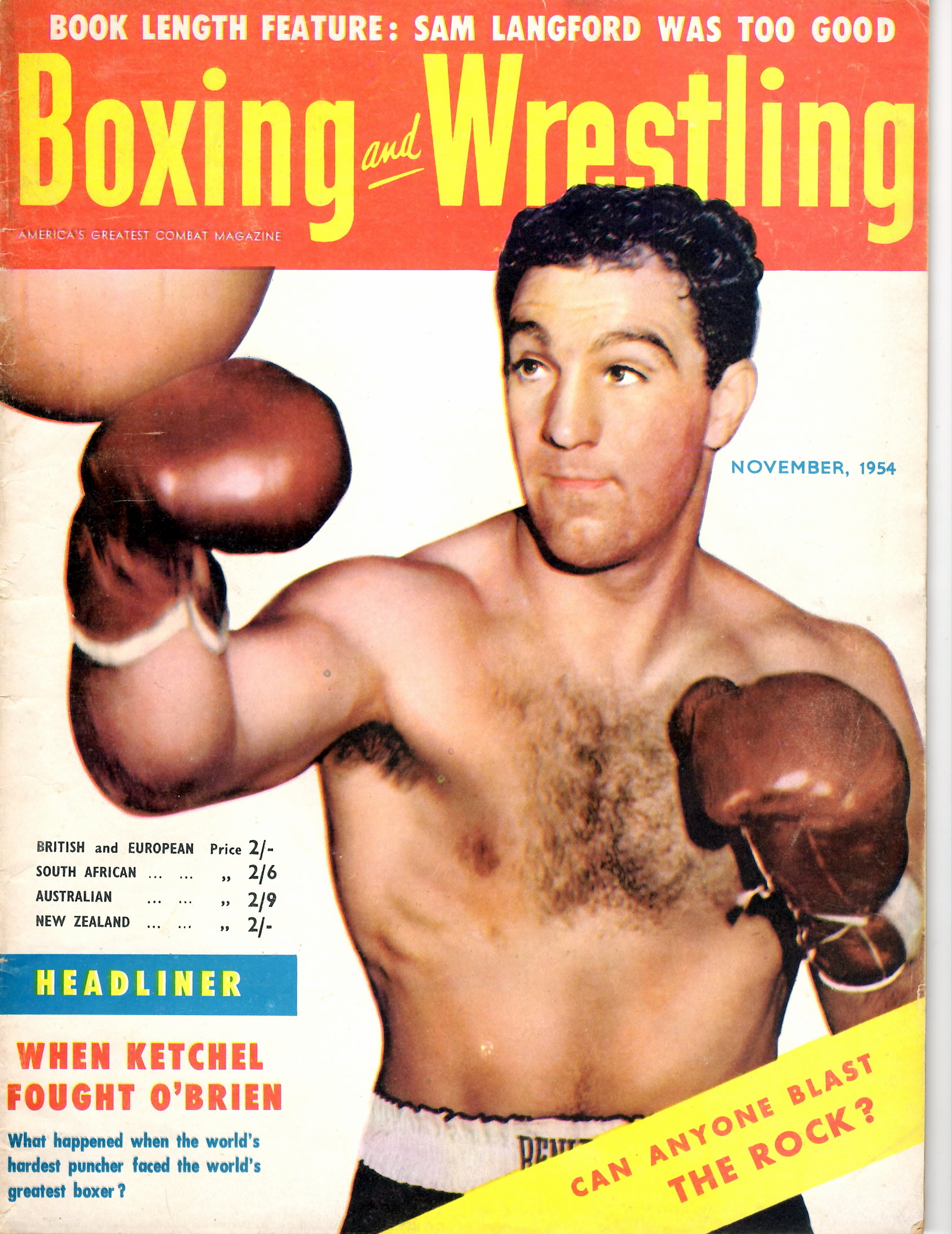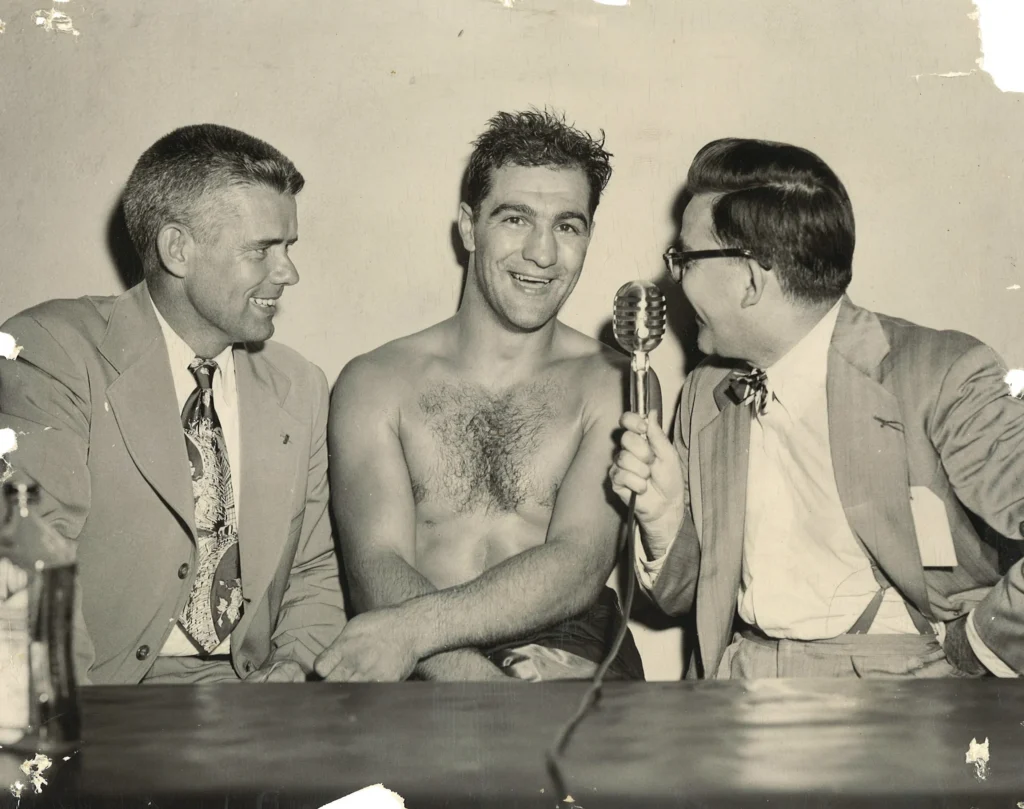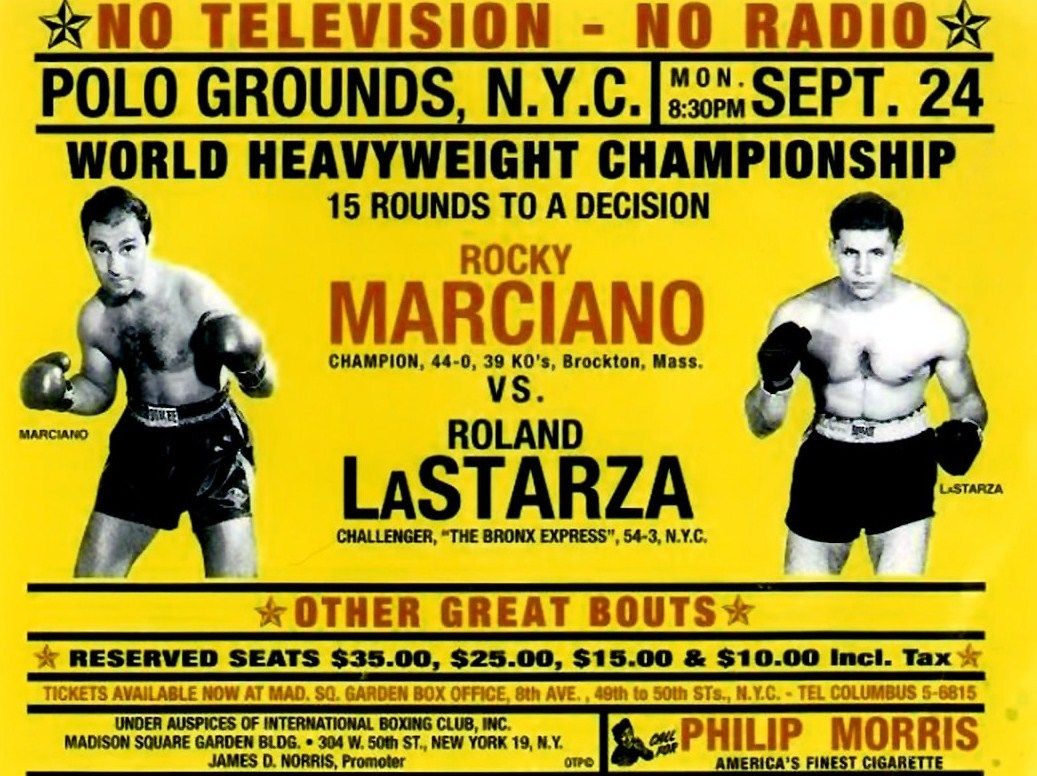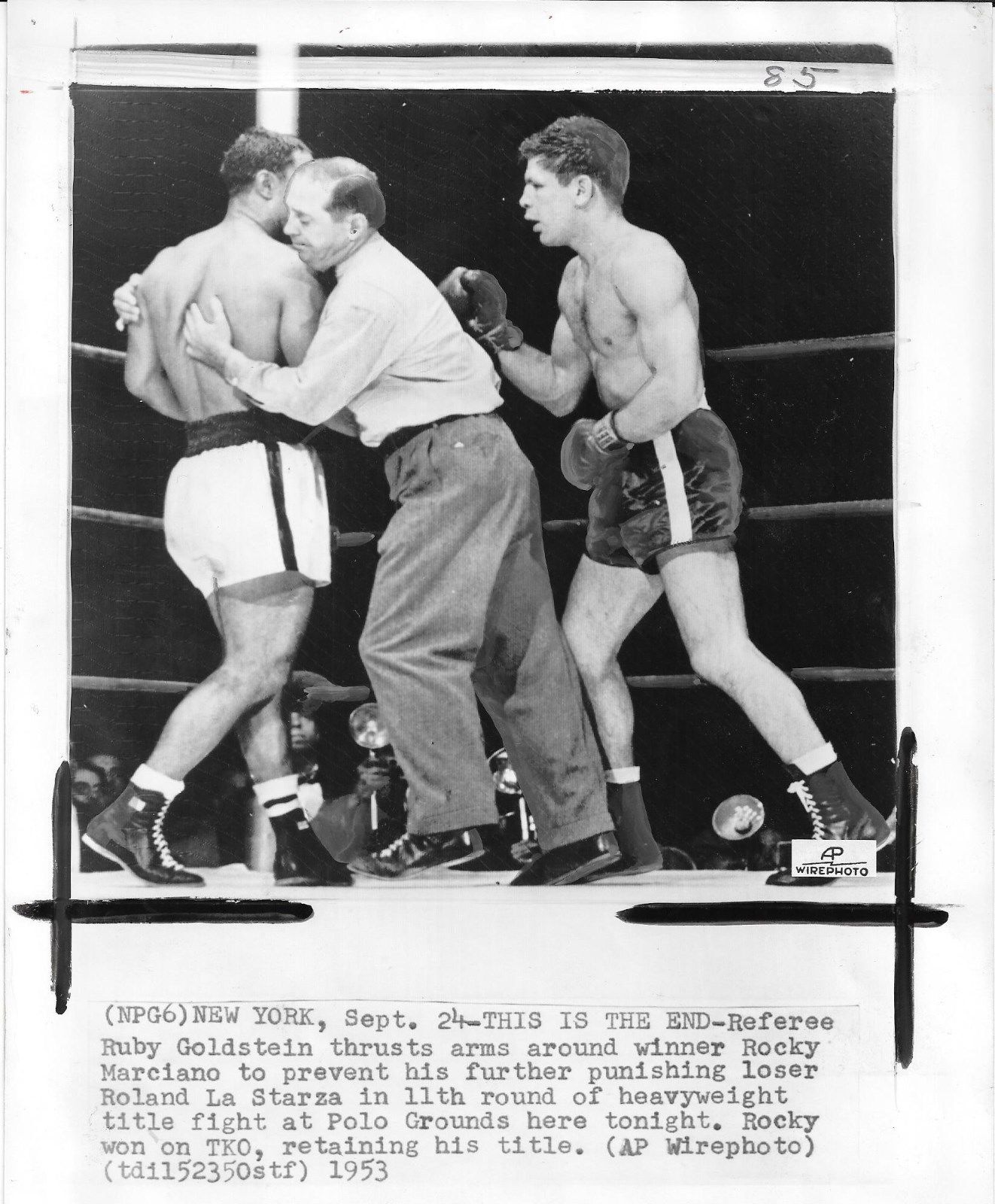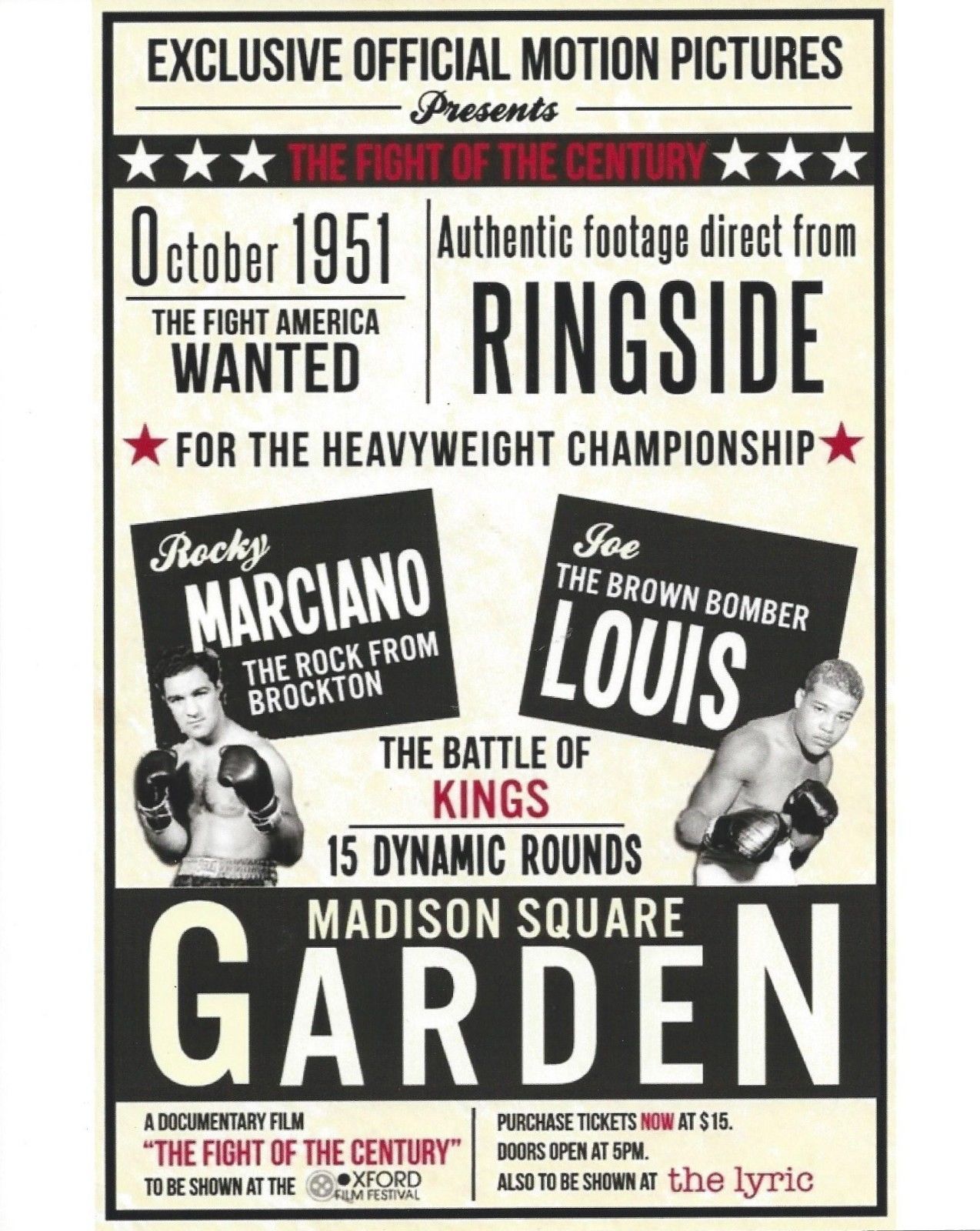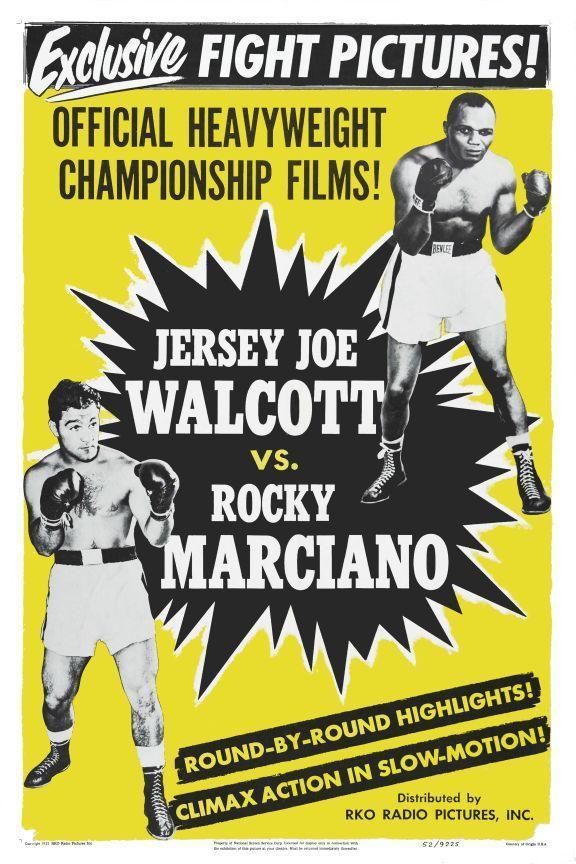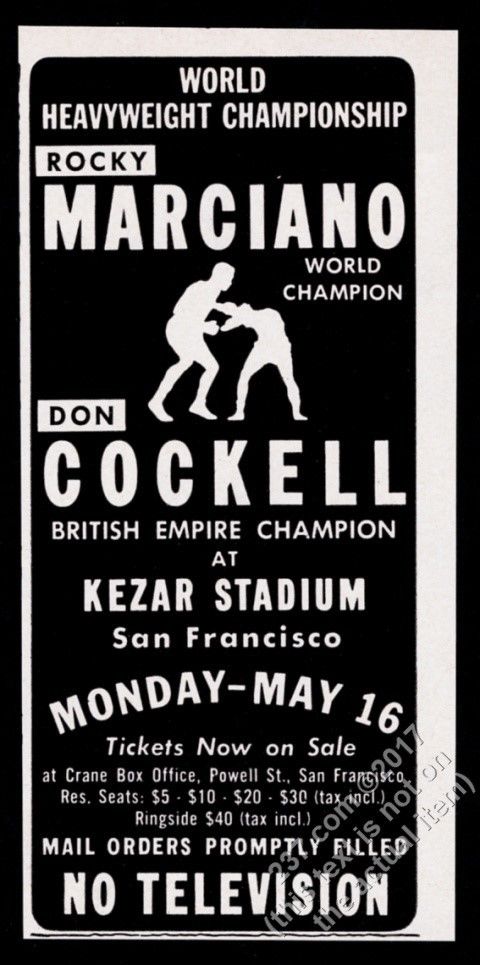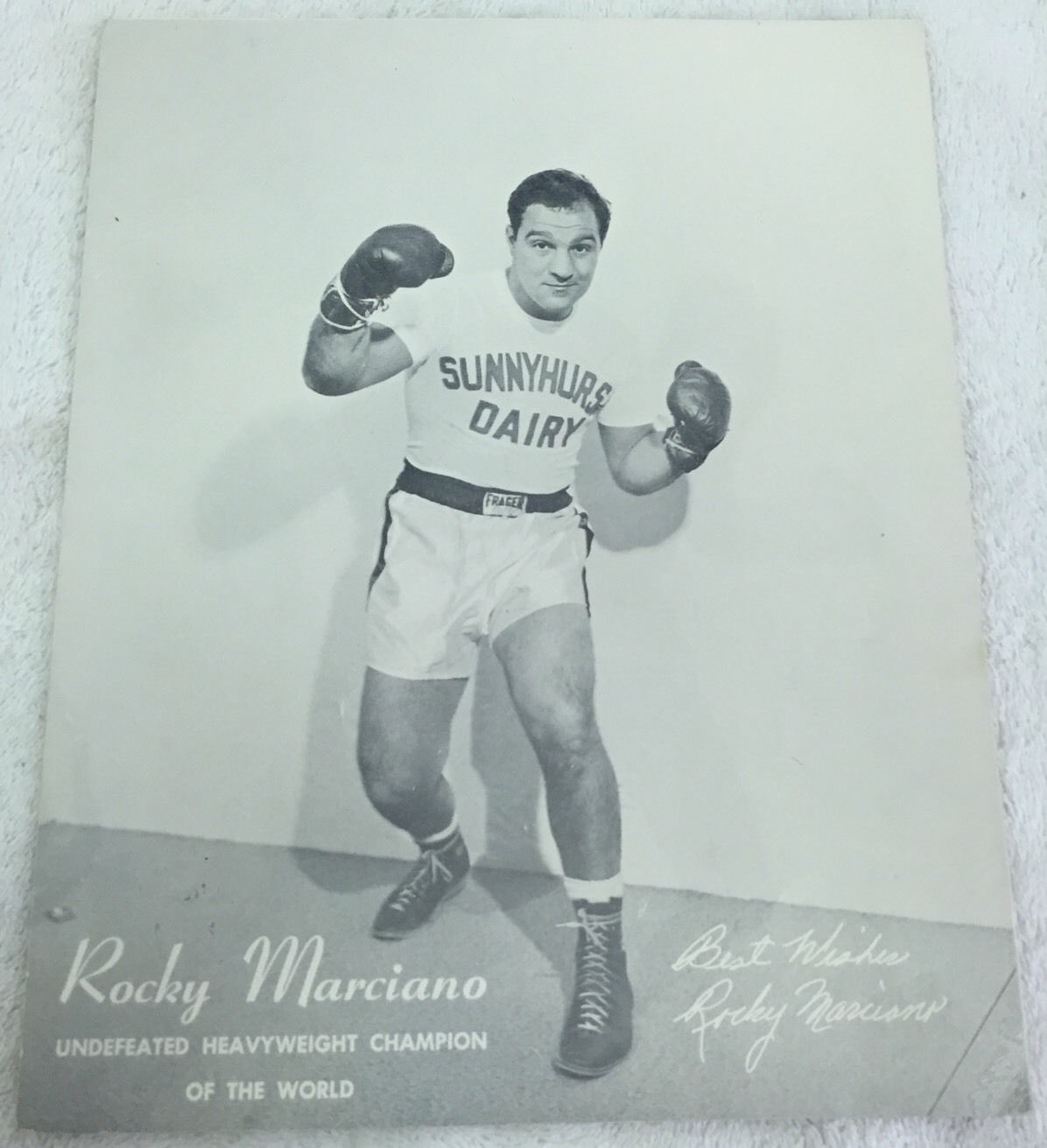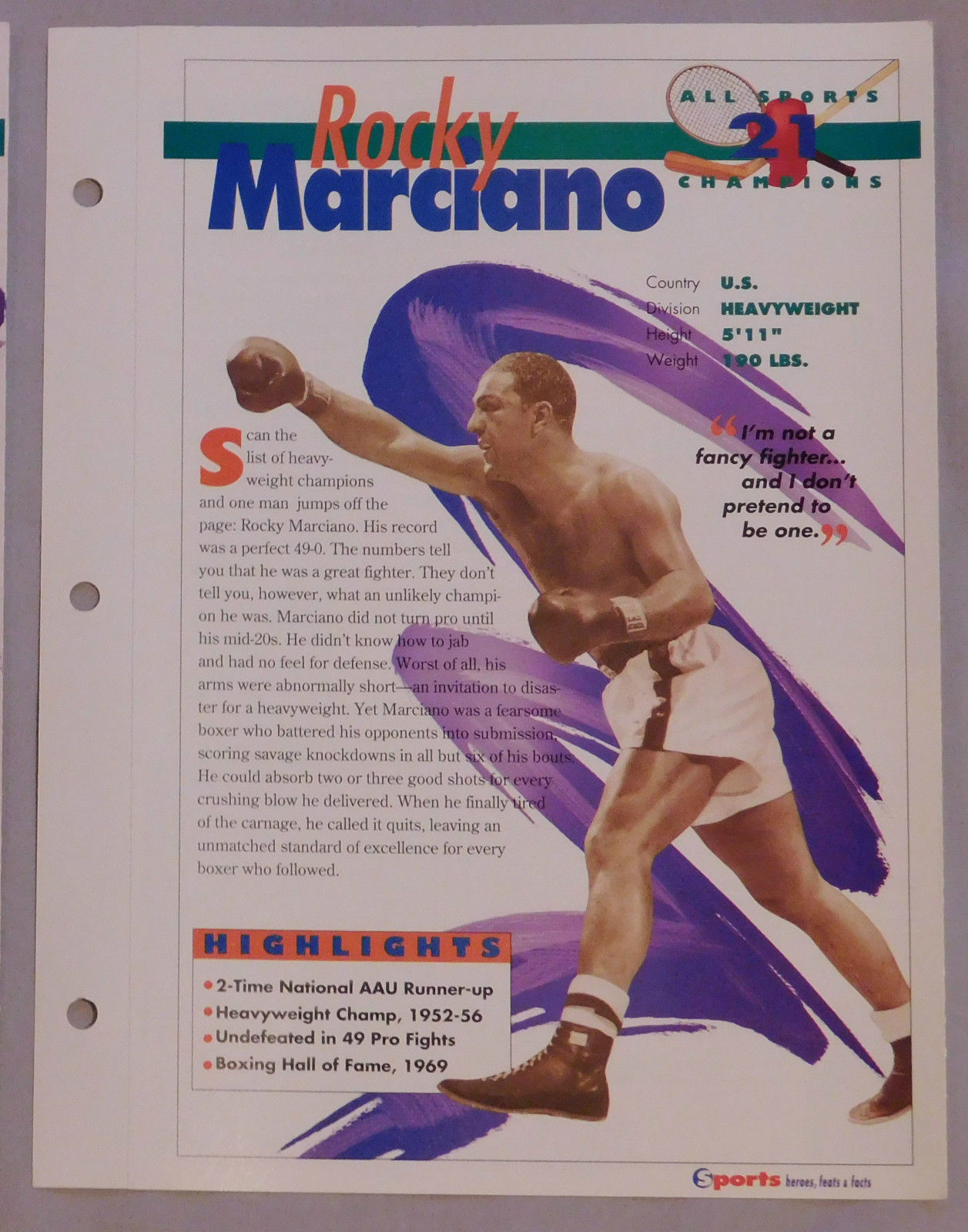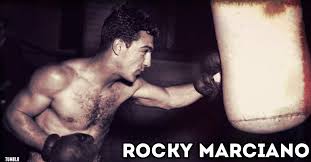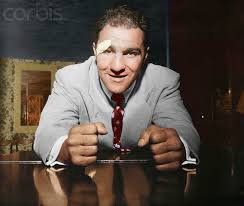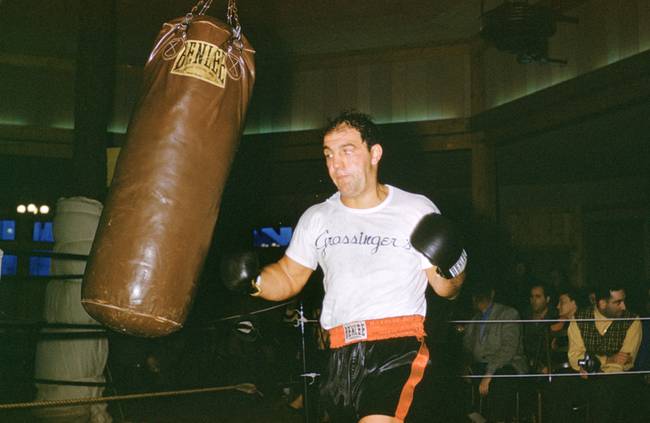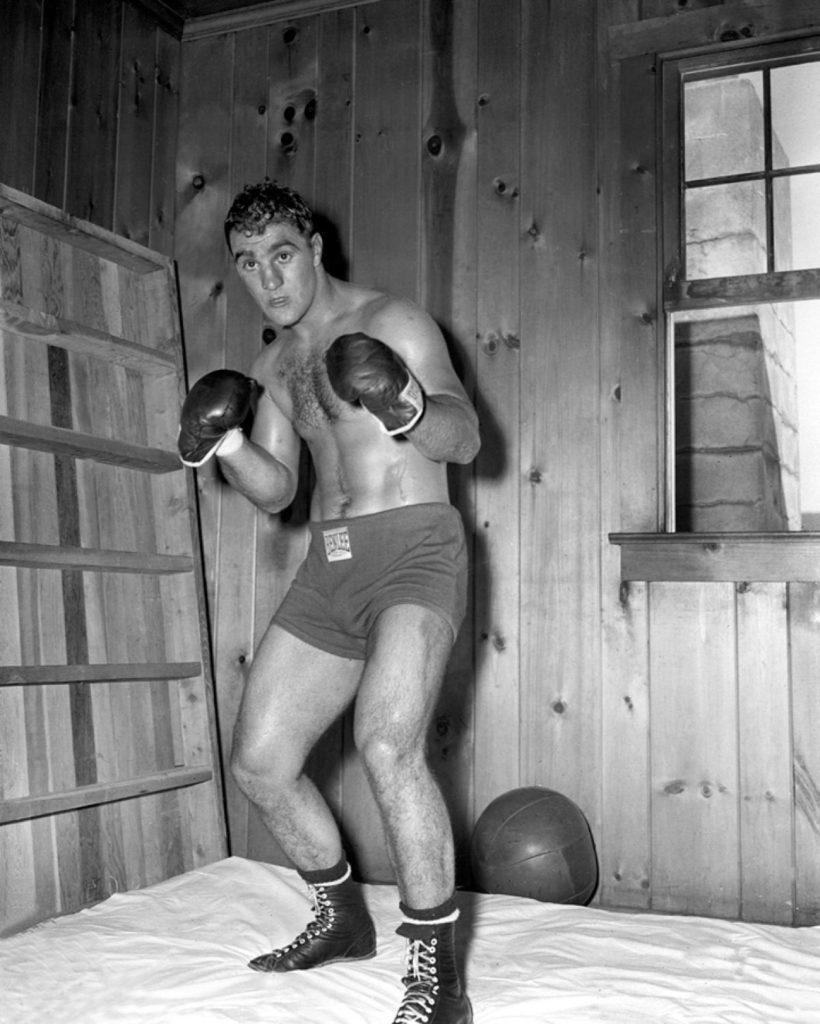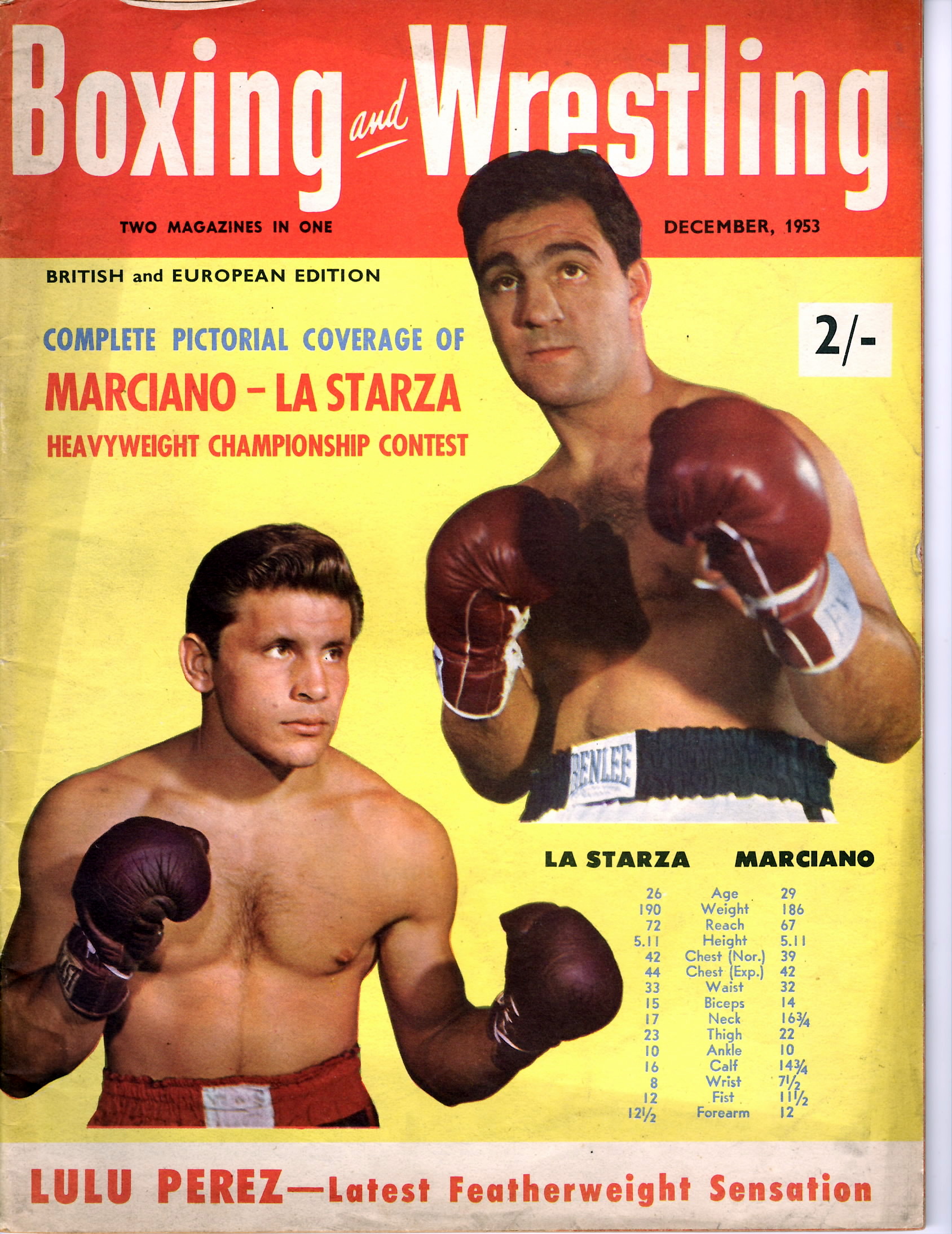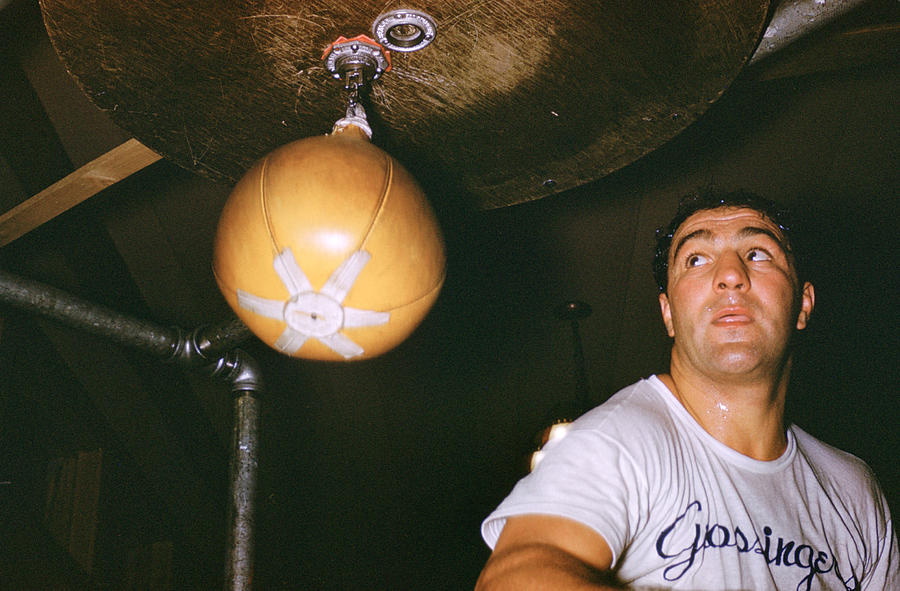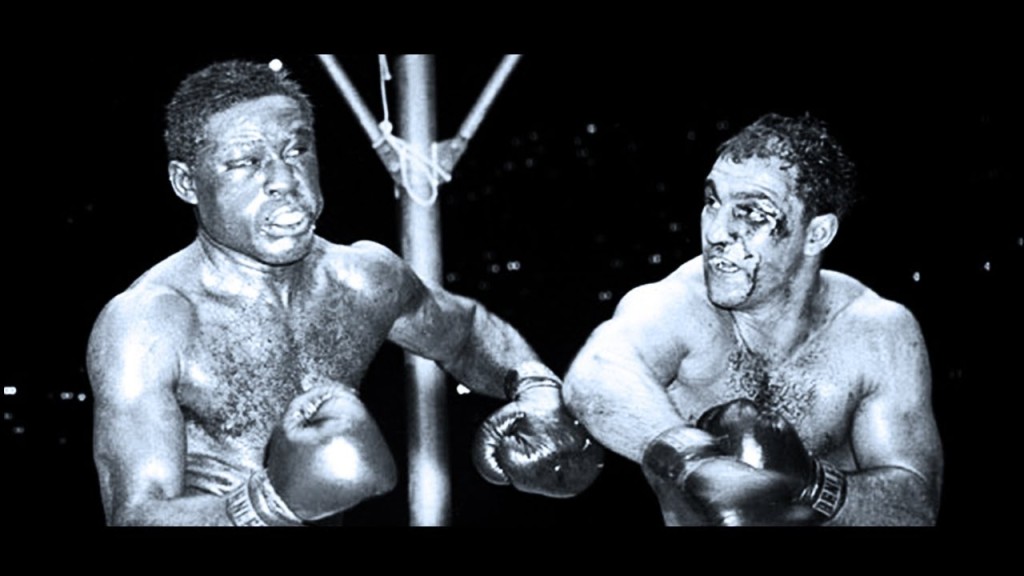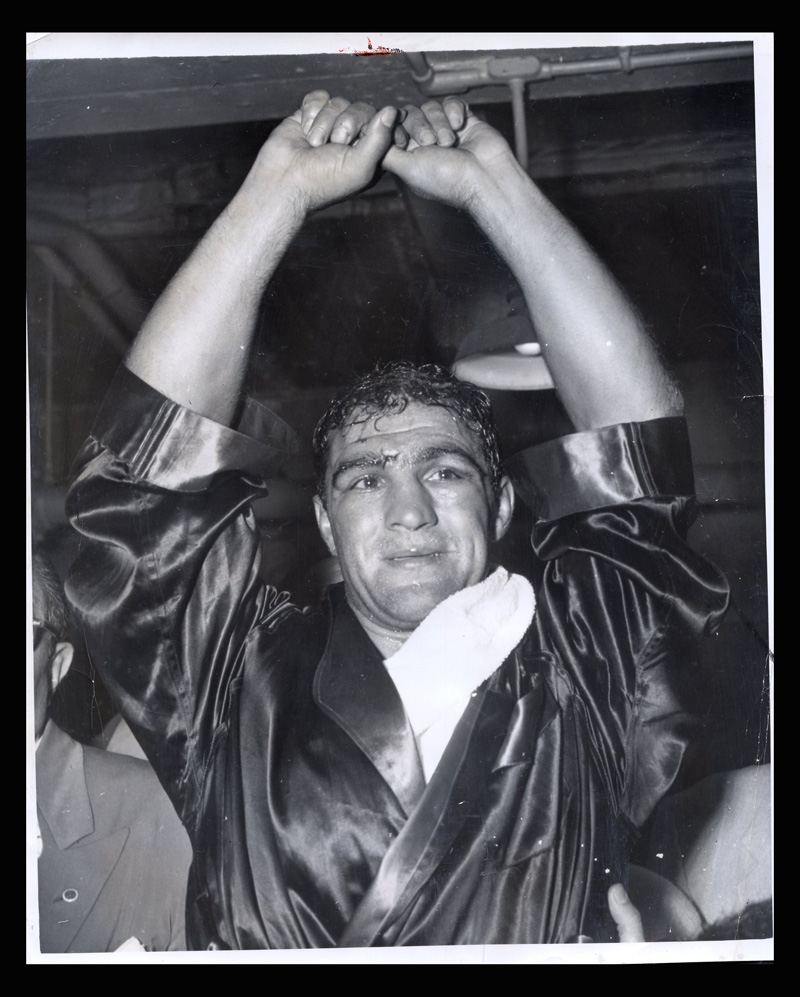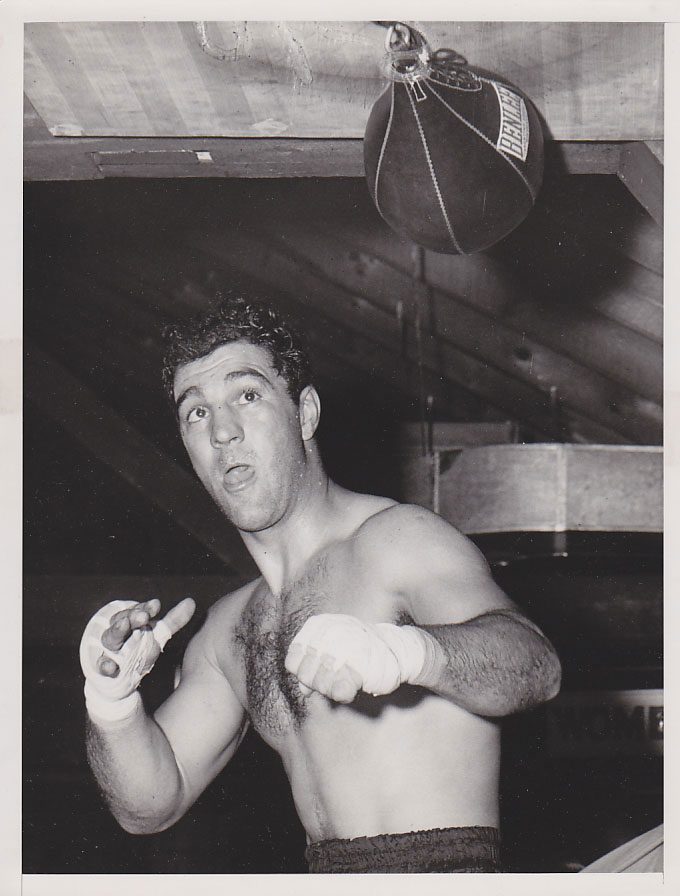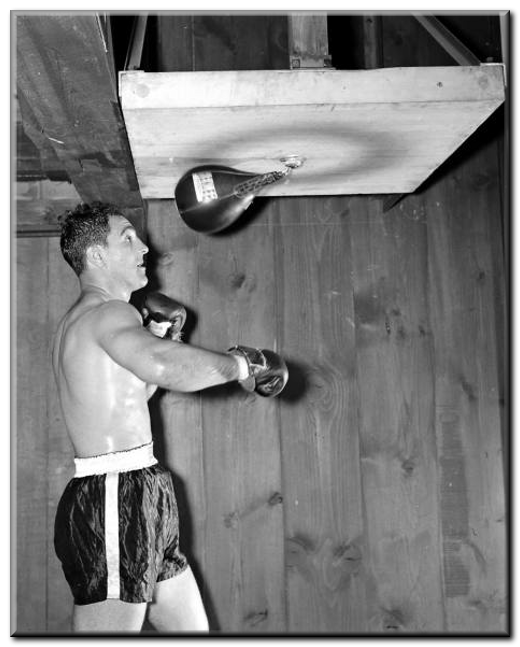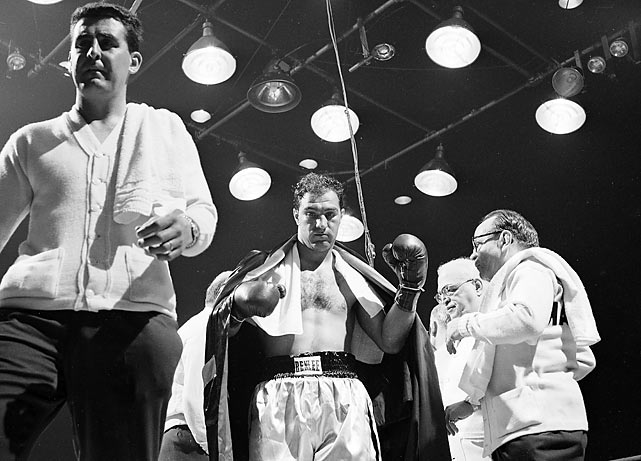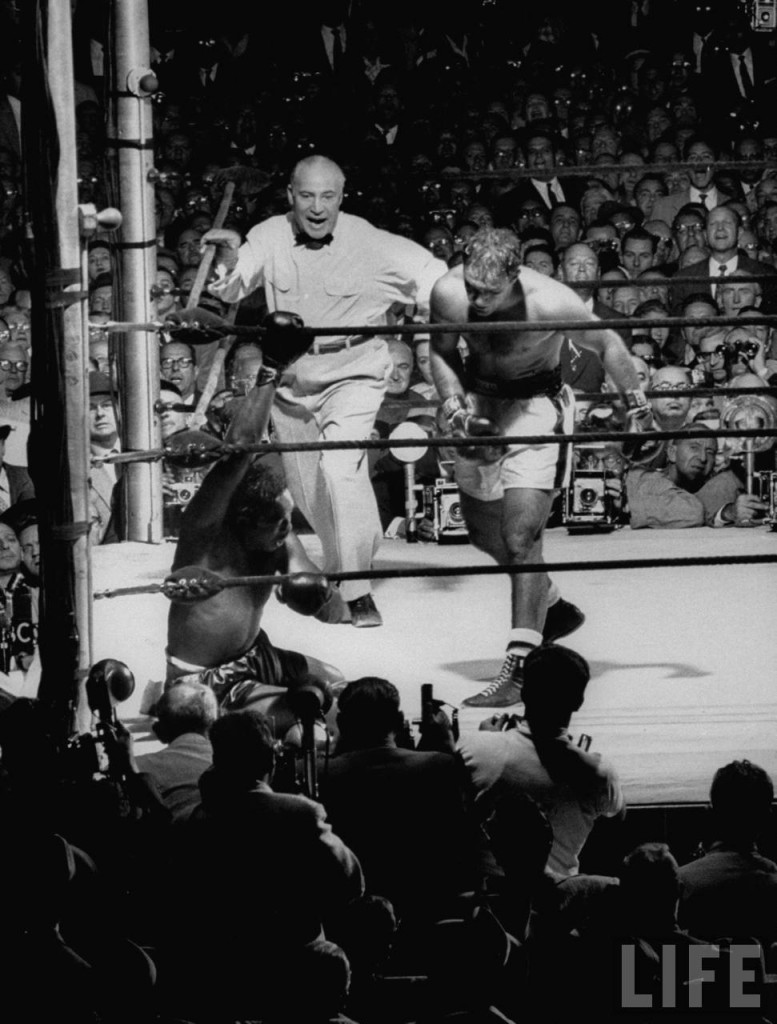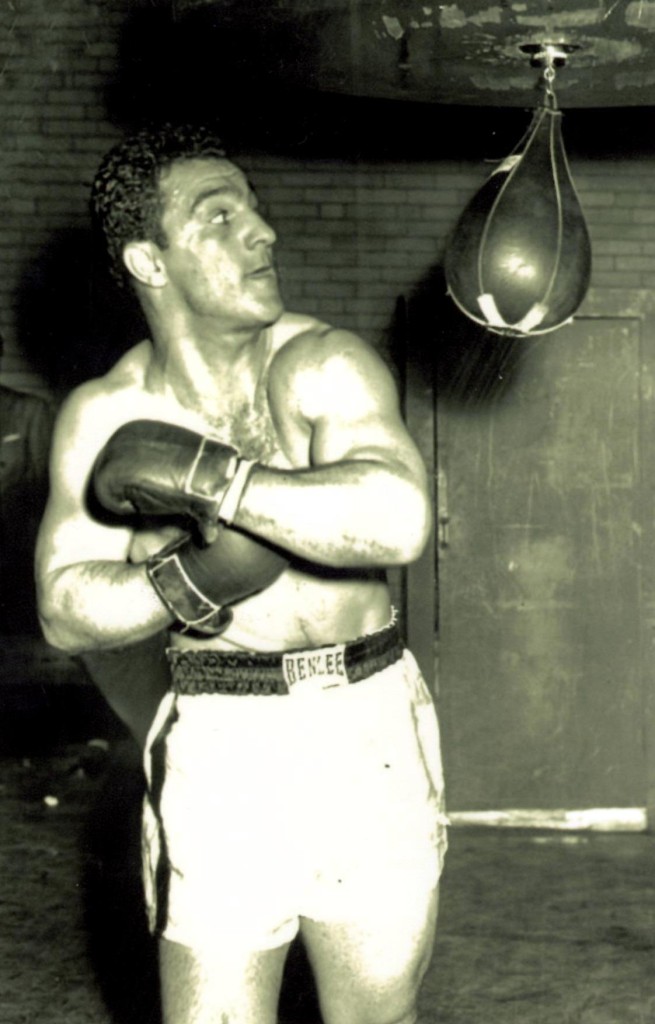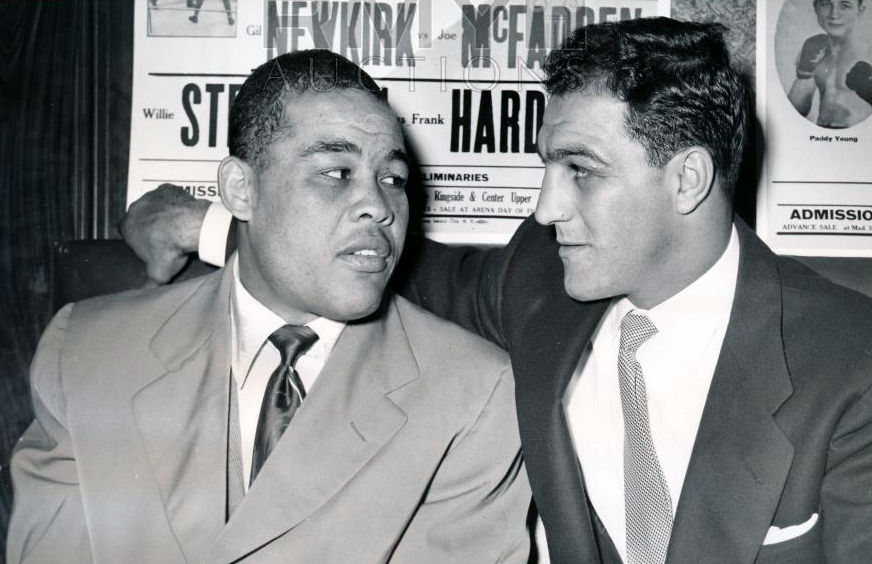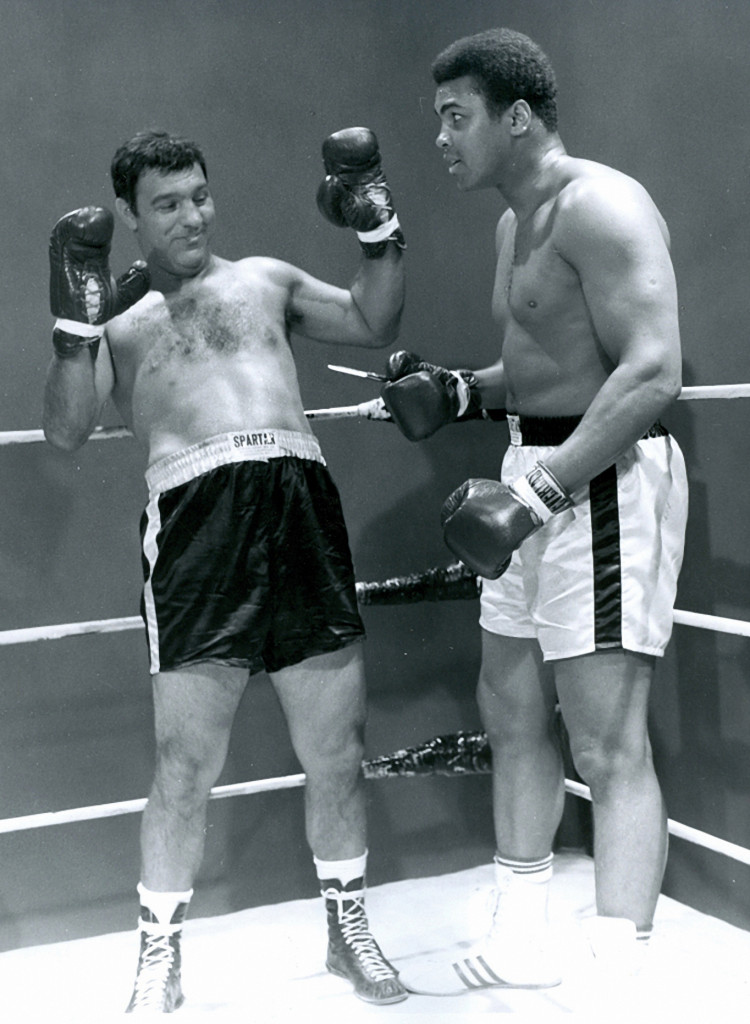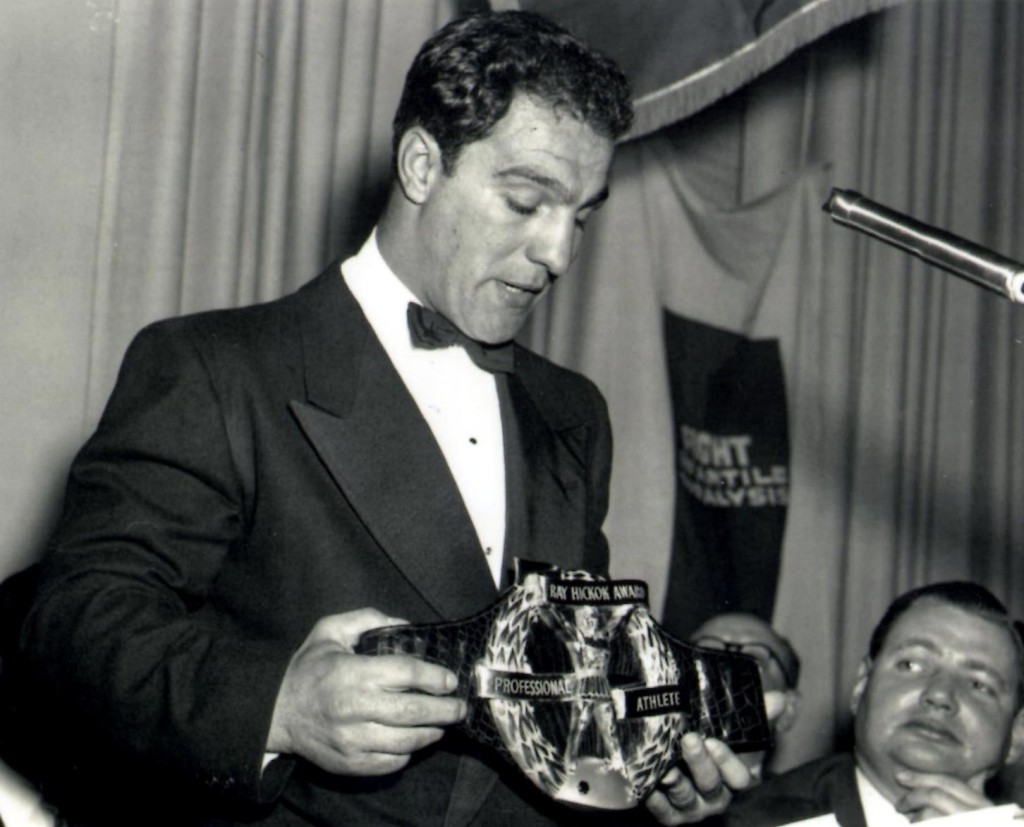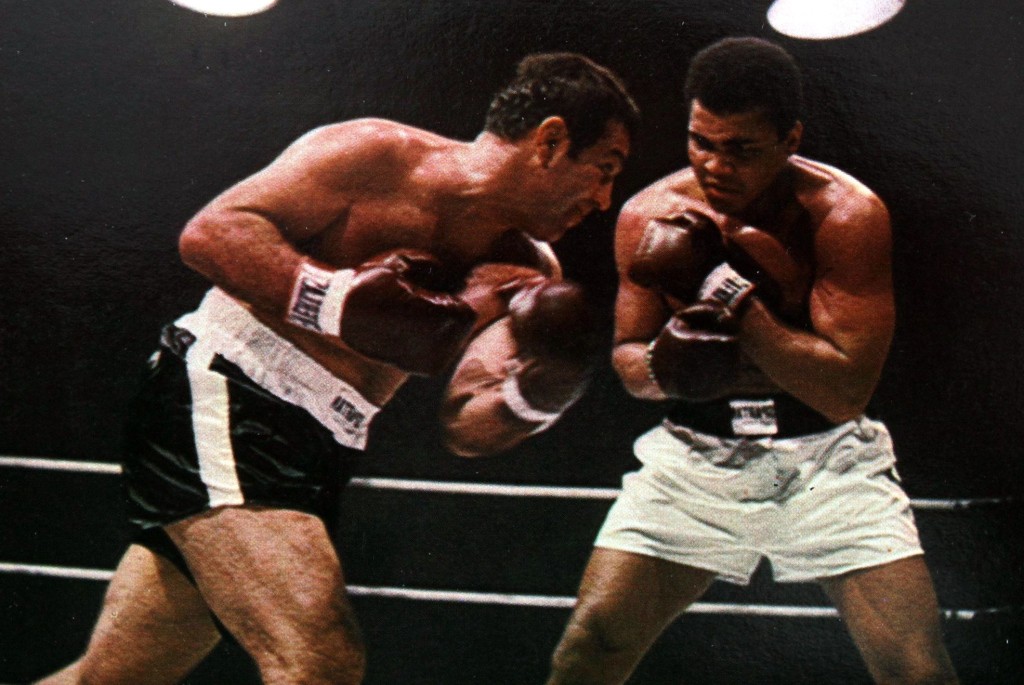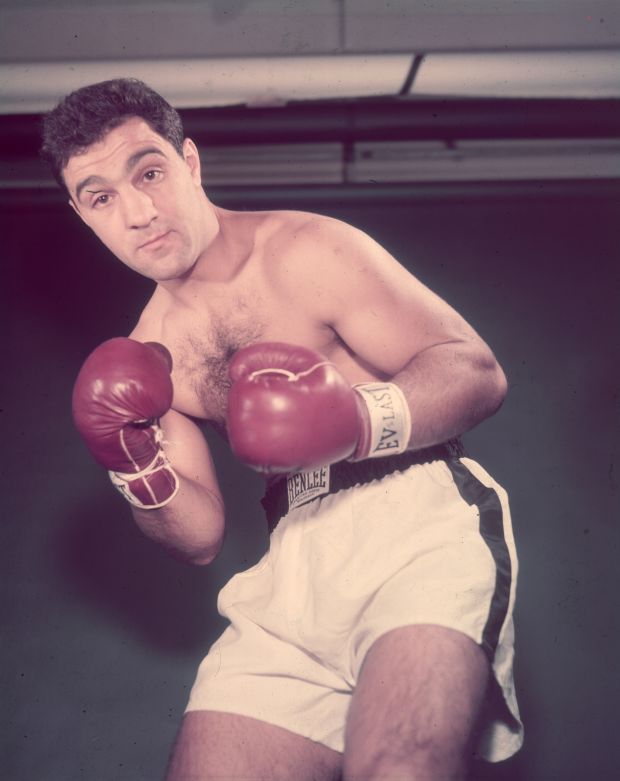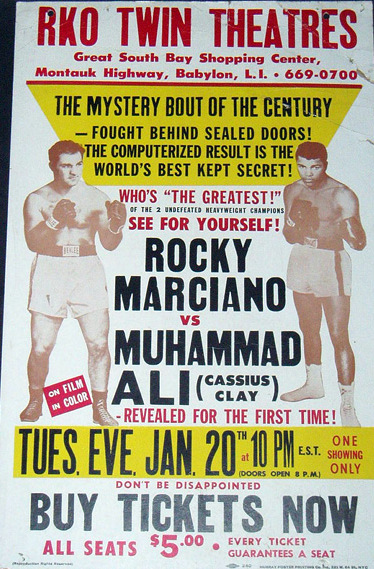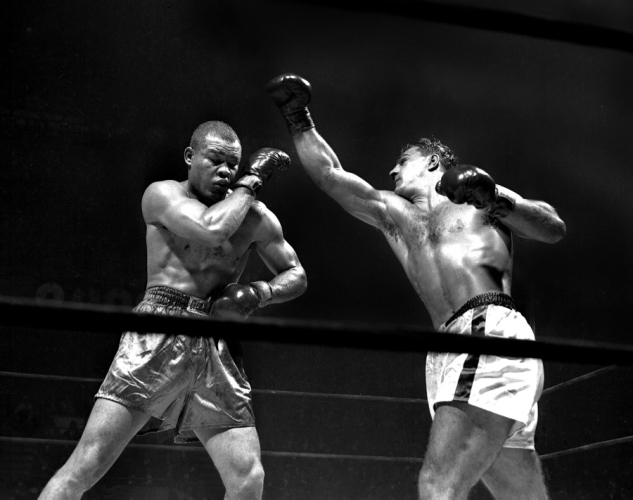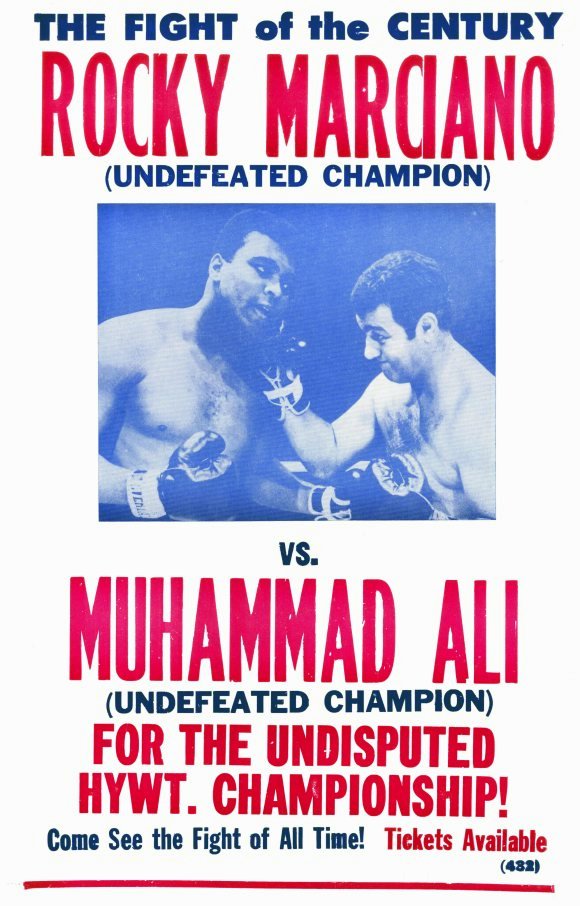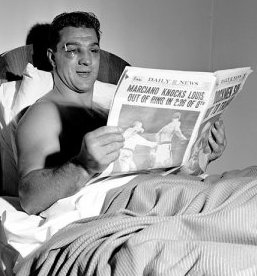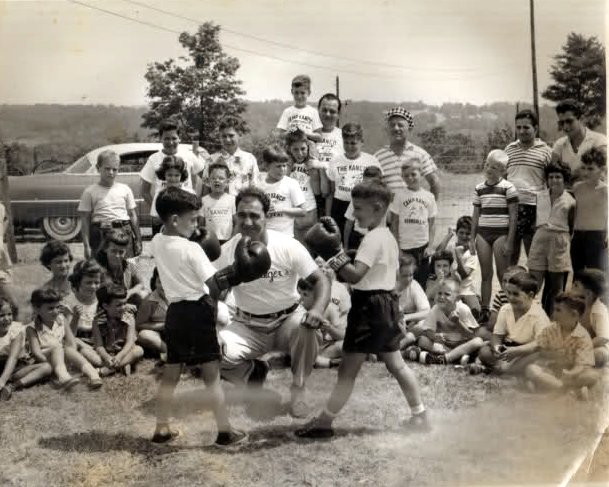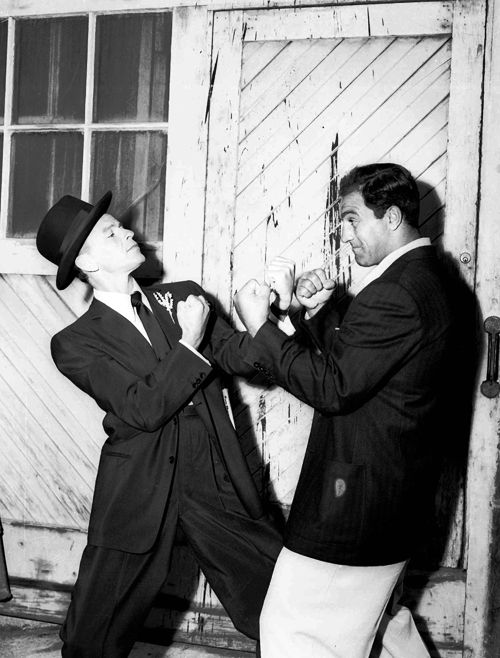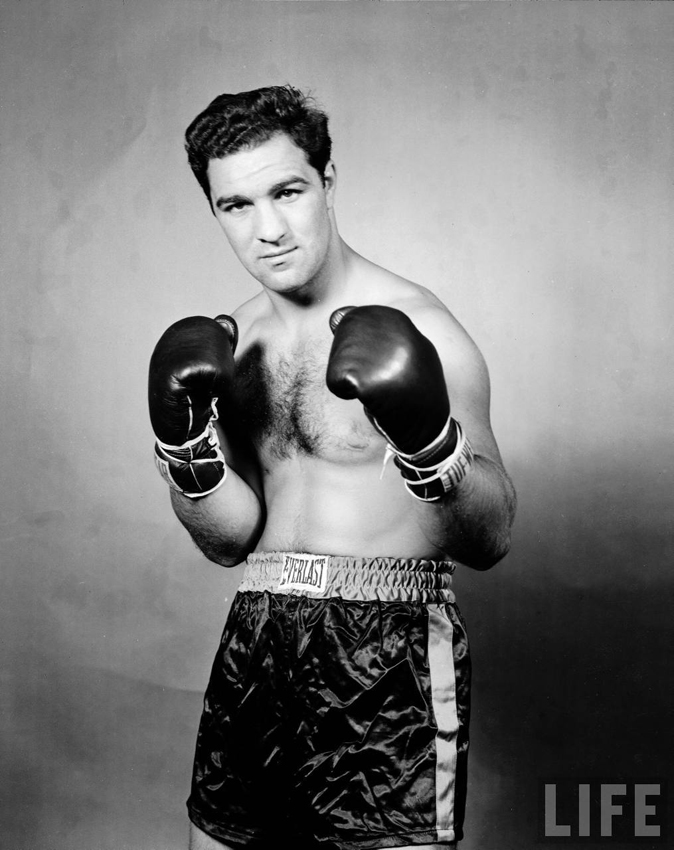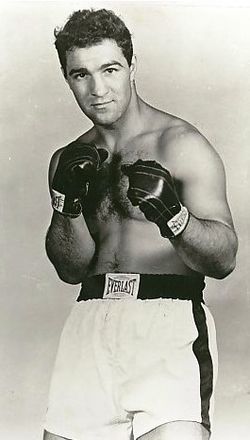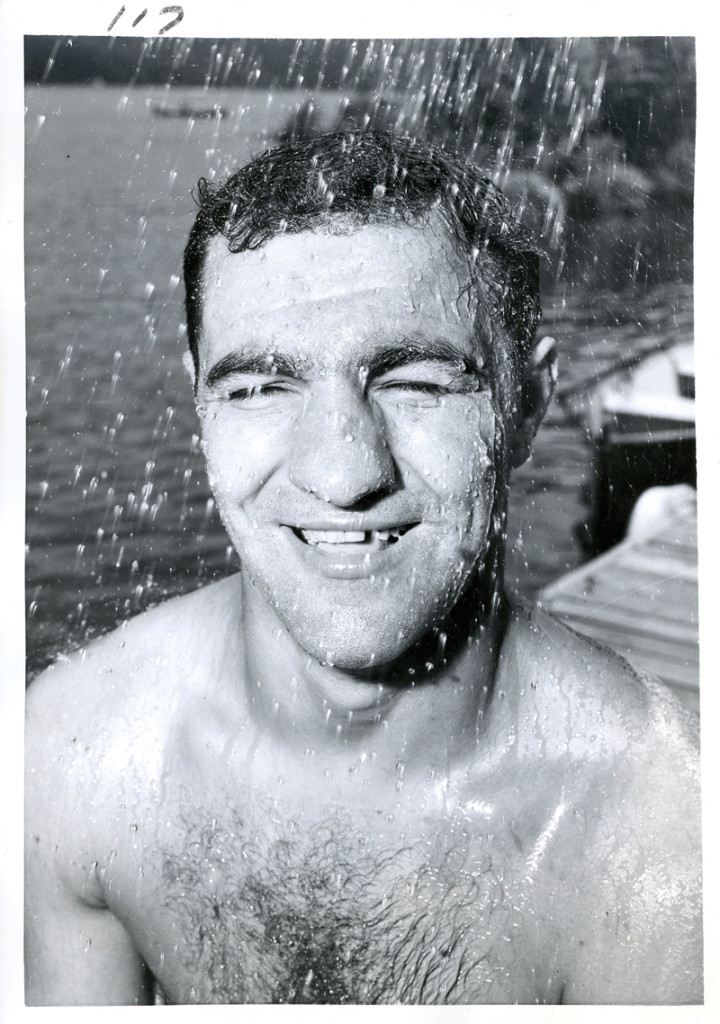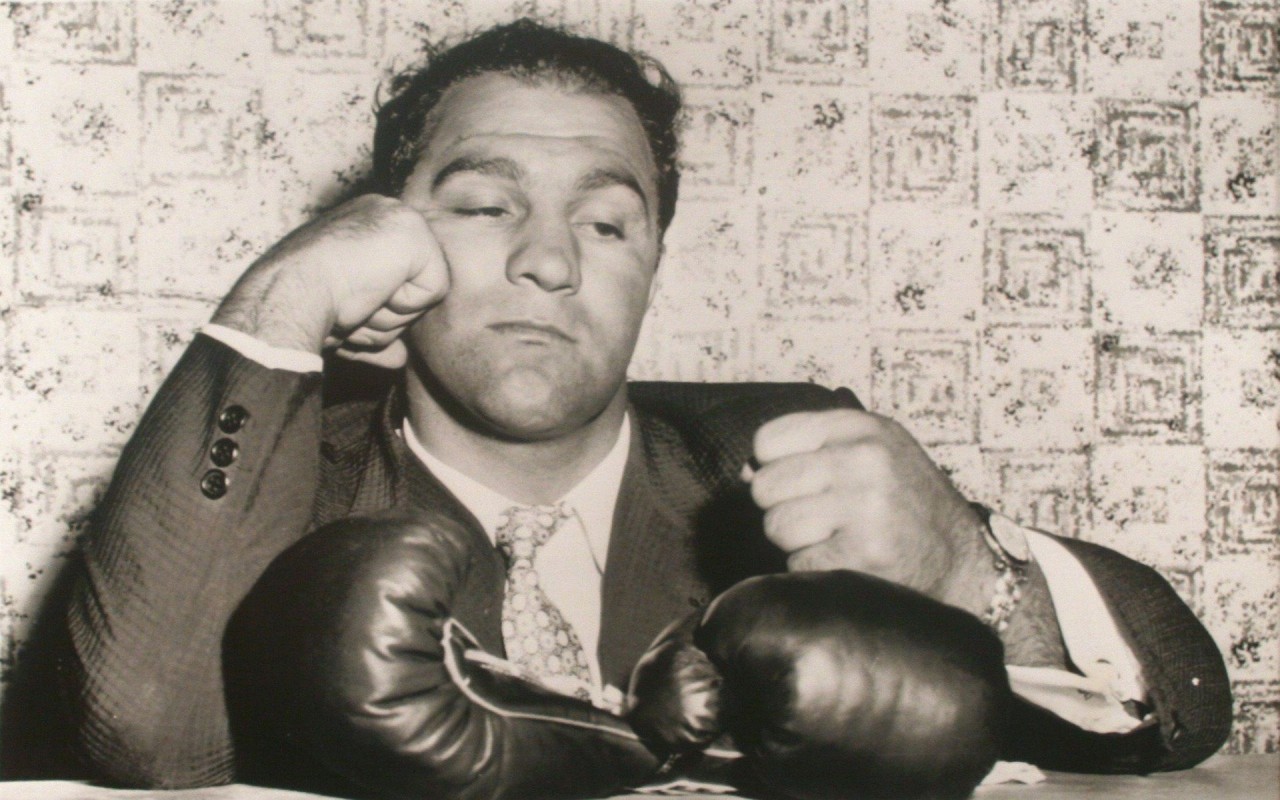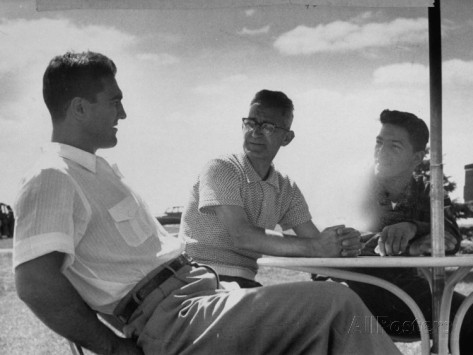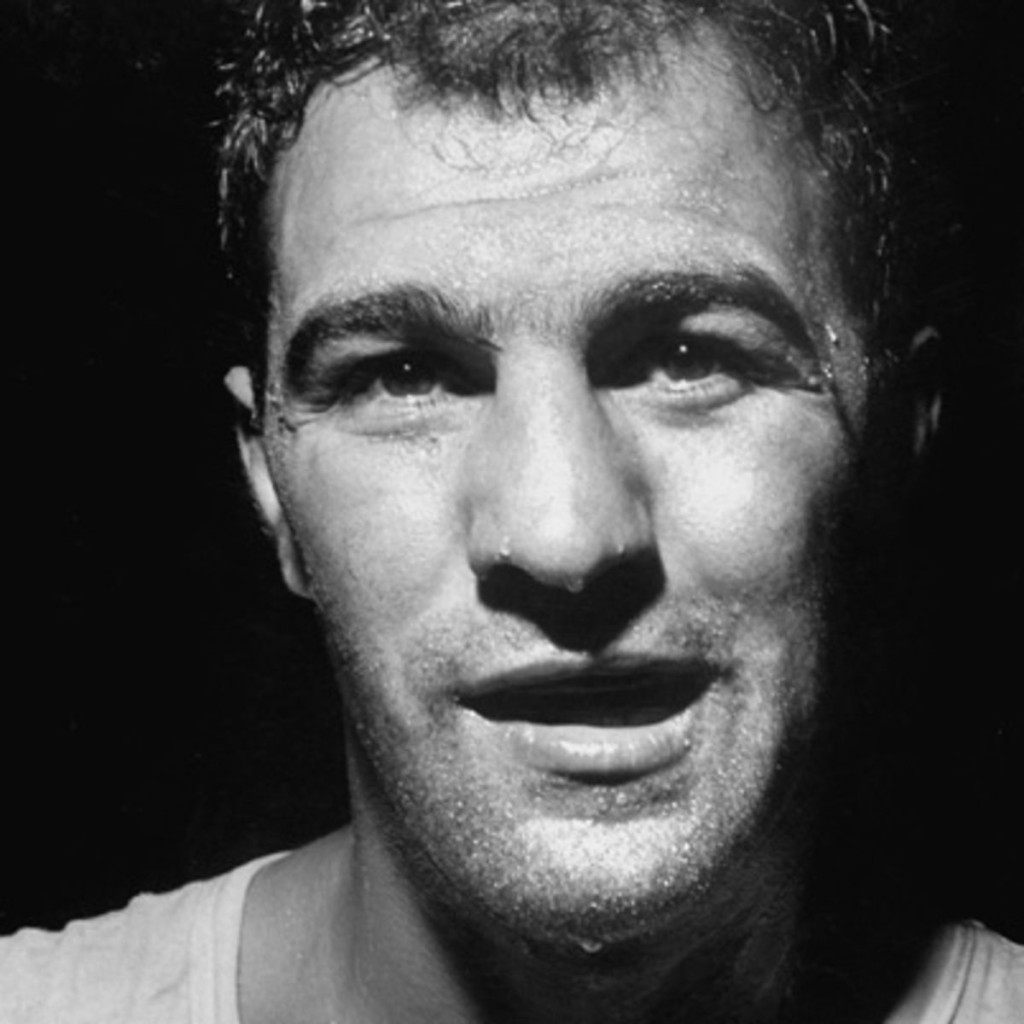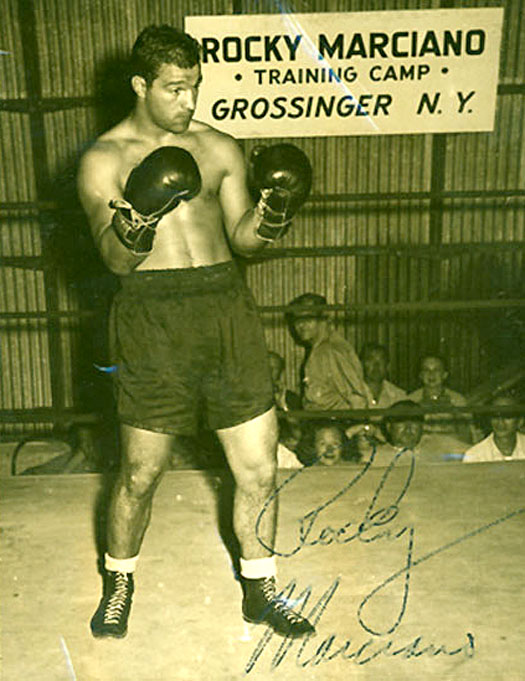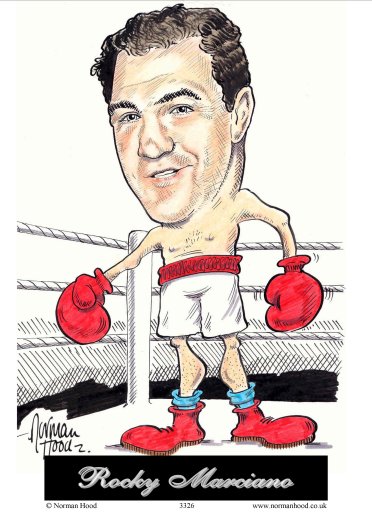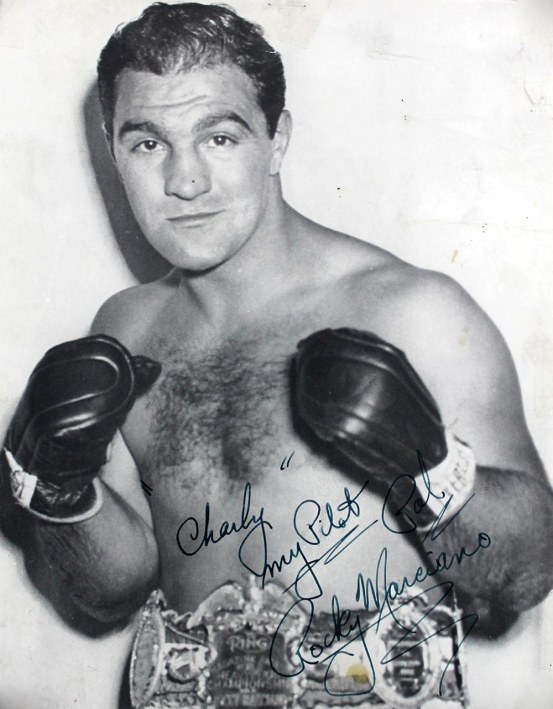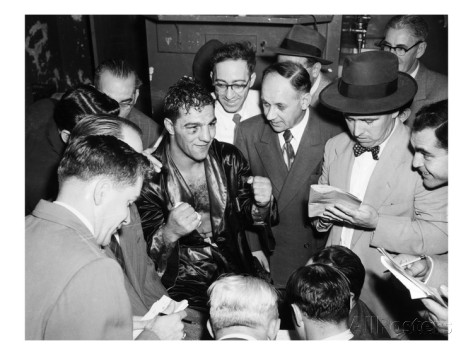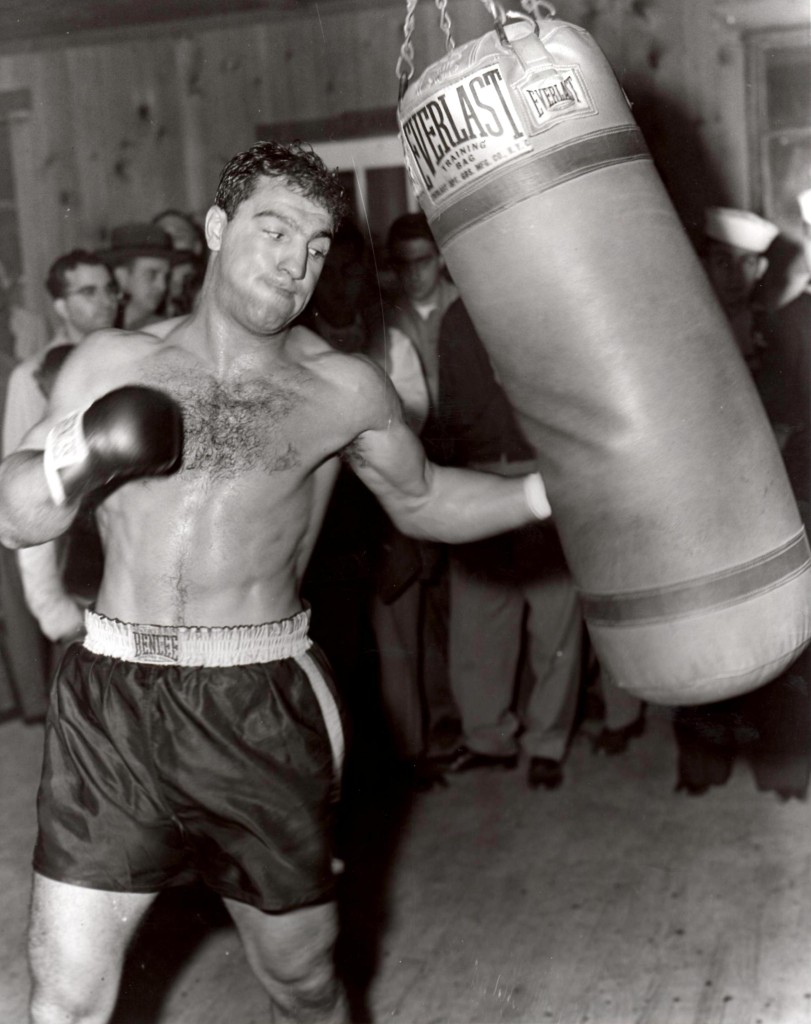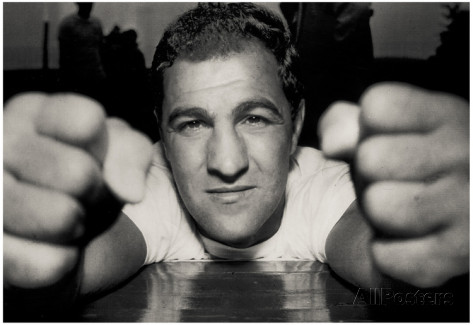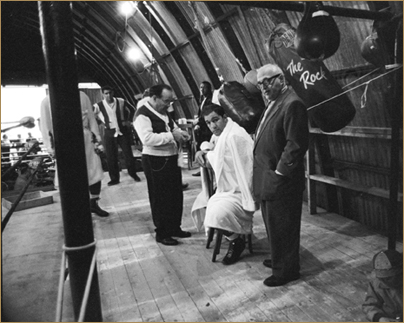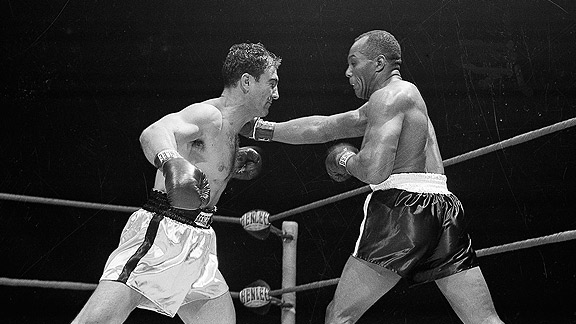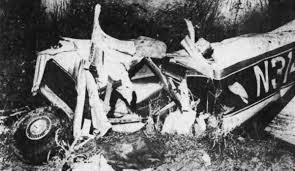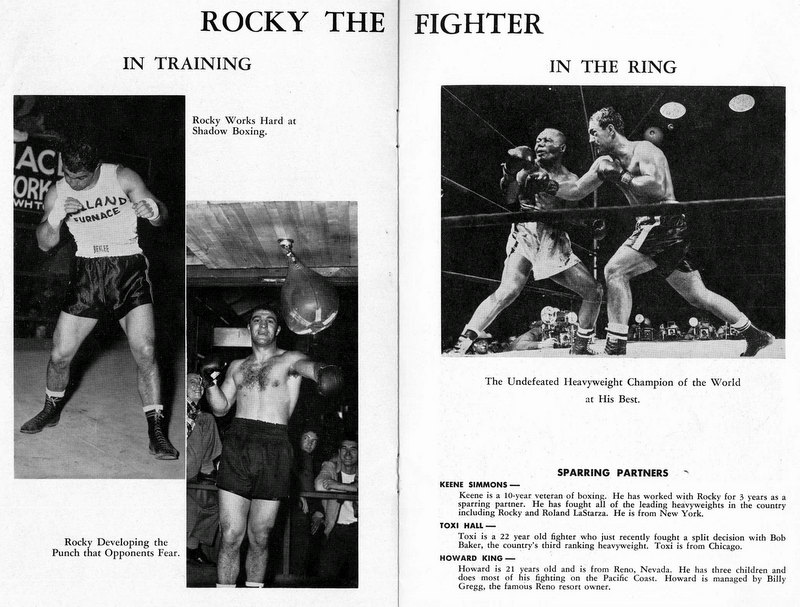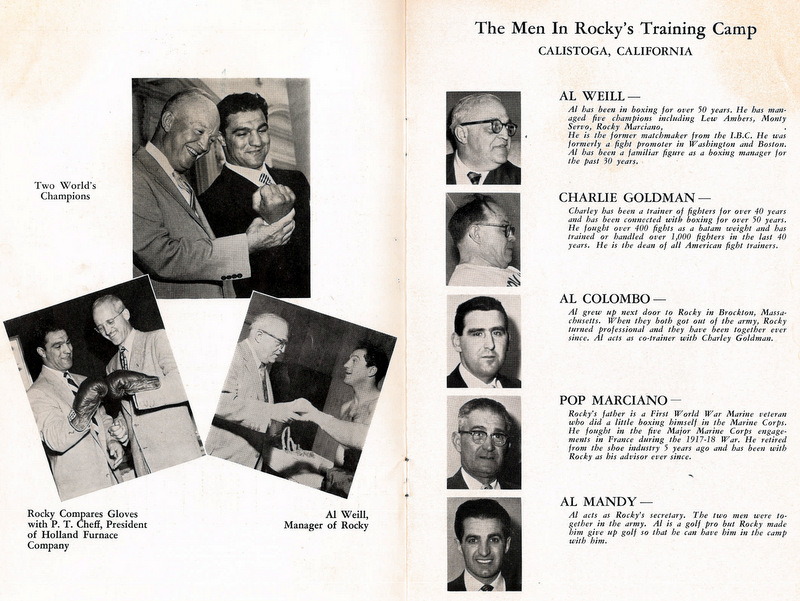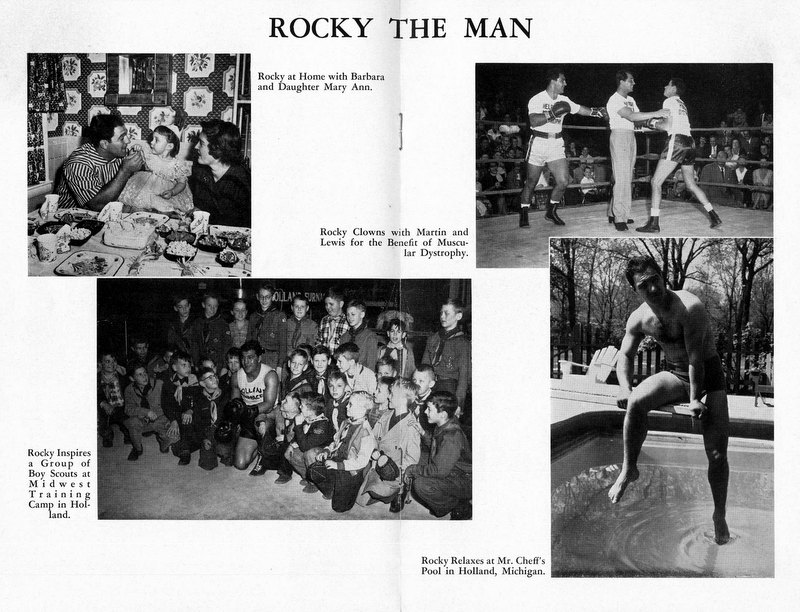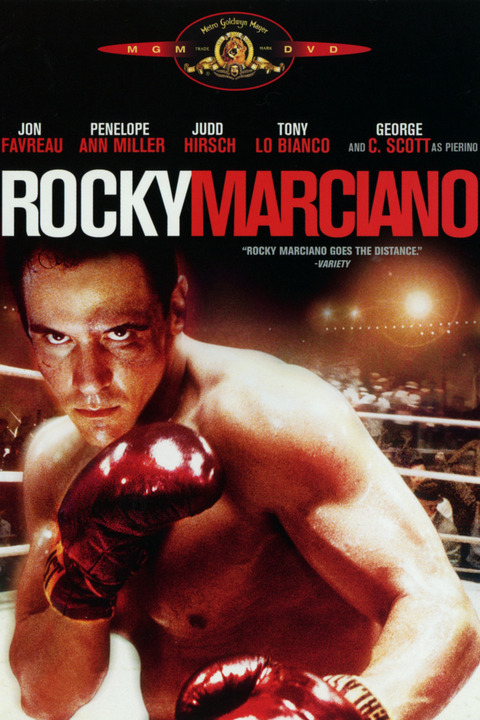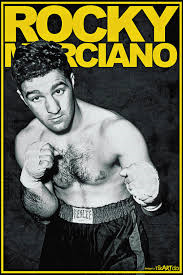 THE UNDEFEATED TERROR OF THE HEAVYWEIGHT DIVISION
THE UNDEFEATED TERROR OF THE HEAVYWEIGHT DIVISION
HIS LIFE AND TIMES IN PHOTOS AND VIDEOS
Rocky Marciano
The Birth of a Great Champion
– Story by John and Alex Rinaldi –
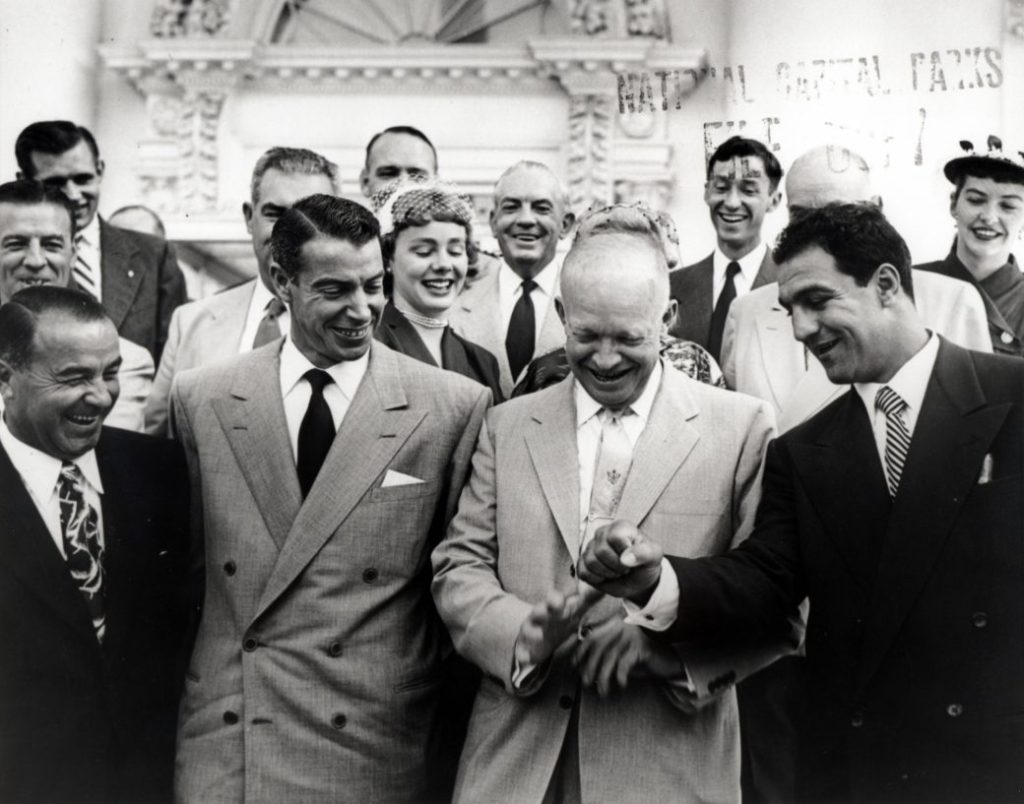
Rocky Marciano (R) with Joe DiMaggio (L) alongside President Dwight Eisenhower (Center). click Photo to see video of the event)
After Jersey Joe Walcott won the heavyweight title from Ezzard Charles, he was anxious to defend his title again and signed on to face the feared, undefeated number-one contender and ring terror Rocky Marciano three months later on September 23, 1952, at the same Municipal Stadium. Marciano had knocked out nearly everyone he had faced in the ring, plus exhibited a tireless and relentless stamina and a knockout blow in either fist. Walcott figured that he was more experienced and could outbox Marciano similar to the way he did against Joe Louis in 1947. Jersey Joe was even cocky when talking about his upcoming opponent Marciano. “Write this down,” he growled to reporters. “He [Marciano] can’t fight. If I don’t lick him, take my name out of the record books.”
 For a fighter who never bragged, Walcott’s comments were quite odd and out of character for him. Rocky Marciano had bludgeoned every top heavyweight out there going into the Walcott fight, including devastating knockout wins over Joe Louis and Rex Layne, two boxers who had beaten Jersey Joe in the past.
For a fighter who never bragged, Walcott’s comments were quite odd and out of character for him. Rocky Marciano had bludgeoned every top heavyweight out there going into the Walcott fight, including devastating knockout wins over Joe Louis and Rex Layne, two boxers who had beaten Jersey Joe in the past.
On September 23, 1952, a raucous crowd of 40,379 fans turned out at Philadelphia’s Municipal Stadium, producing gate receipts of $504,545 for Walcott’s defense against Rocky Marciano. The fight was also shown on closed circuit TV in 50 theaters in 31 cities throughout the United States. The closed-circuit television receipts totaled $125,000. Joe’s second title defense earned him $188,070, while the challenger Marciano took home $94,035. The previous year, Joe DiMaggio was the highest earning baseball player collecting a $100,000 salary from the New York Yankees. Walcott nearly doubled that figure in just one fight!
To everyone’s astonishment, Walcott came out slugging against his dangerous opponent and lashed out with a left hook that landed squarely on Marciano’s jaw that sent “The Brockton Blockbuster” to the canvas! The challenger got up quickly and appeared unhurt, even though this was nearly the same punch that had Ezzard Charles down for the ten-count when Walcott KO’d him in the seventh round in their July 18, 1951 bout at Forbes Field in Pittsburgh, Pennsylvania.
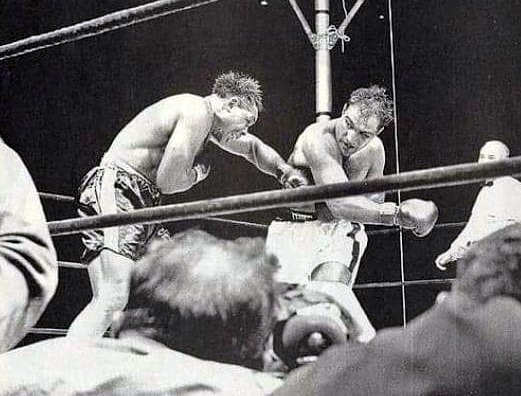
Heavyweight Champion Rocky Marciano (R) pounding away at challenger Archie Moore (L) in their epic 1955 battle.
After the referee wiped the resin off the Rocky’s gloves, the two then exchanged heavy leather fists for the remainder of the opening round.
After the aggressive first round, Walcott began to box and punch, instead of just firing away with bombs. Unbeknownst to the champion Walcott, Marciano possessed the superhuman, relentless style of forcing his opponents to fight at a whirlwind pace that they were normally not accustomed to. Luckily for Jersey Joe, he was also in top-notch shape, so much so that he was able to put on one of the most exciting displays of scientific fisticuffs ever seen within the roped square.
By the middle frames it appeared that Rocky was about to turn the tide due to his savage body blows, but then the challenger began to rub at his eyes and swing wildly.
What had happened was that Walcott’s gloves or shoulder had a liniment on them that somehow blinded Marciano. Because of this new development, the champion took advantage of his foe’s unfortunate predicament and began to up points with swift, jolting combinations. Since Rocky was able to take the shots, he just kept coming forward. Although the challenger kept on advancing, he was still being outpunched by Jersey Joe and was noticeably losing the fight.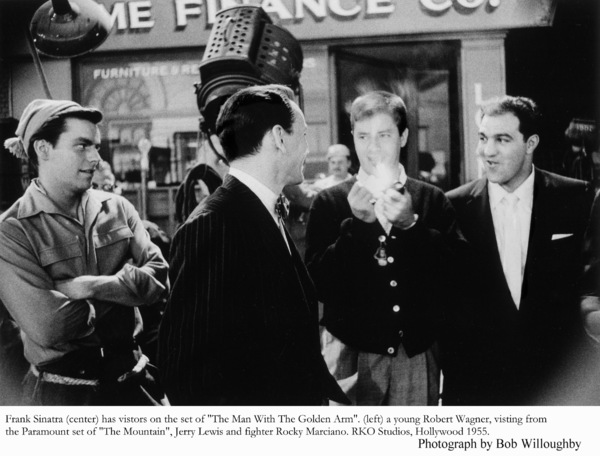
By Round 12, the Rocky’s vision had managed to clear up and he was as dangerous as ever as he pounded away at the champion with both powerful fists slamming into Walcott’s skull and ribs.
Nonetheless, going into Round 13, Walcott had built up a commanding lead and was ahead in rounds by scores of 8-4, 7-5 and 7-4-1. Because of this, even if he lost every succeeding round, all that Walcott had to do was simply stay on his feet and he would still keep his heavyweight title by way of a draw. Unfortunately for Jersey Joe, Marciano was not the type of fighter who wanted his opponents to hear the clang of the final bell.

Heavyweight Champion Rocky Marciano kidding around with a lucky young fan during training at Grossinger’s Resort.
When the 13th round started, the challenger Marciano, fighting out of his effective crouch and bobbing and weaving, advanced towards his rival and hammered away with blistering blows that soon backed the champion up against the ropes. Just when Walcott was about to throw his right hand, Rocky fired his right fist first that exploded on Jersey Joe’s jaw with the force of a meteor that nearly caved his face in! As if shot by a cannon, the champion began to slowly collapse, whereby Rocky hit him with one more final telling blow – a thudding left hook to the skull before he went down for good. With his left arm hanging on the ring ropes like a broken coat hanger, Walcott looked like a battered rag doll. He then crumbled twisted to the canvas where he was counted out by referee Charlie Daggert at 0:43 of Round 13.
Walcot lay so listless and lifeless on the canvas that the referee could have counted to a thousand.
It was such a great battle that it was voted the Fight of the Year for 1952 and the 13th Round was awarded Round of the Year.
Though Jersey Joe was now the ex-champion, he did have in his contract a return bout clause that not only got him an immediate shot to reclaim his lost laurels, but he would also earn more than the new champion, something that Marciano was certainly not too happy about.
On May 15, 1953, 16,034 fans turned out at Chicago Stadium to see if Walcott could win back his title. The live gate was $253,462.37 and the home television and radio revenue amounted to an additional $300,000. The promoters were the International Boxing Club, who were a pitiful outfit that made the fight available free to fans in their homes via TV and radio. Because fans did not have to leave their homes to view the contest, the live gate was financially crippled, which accounted for the poor turnout of 16,034. The obvious question was why would fans hop in their cars or take the train to Chicago, when they could see the fight on TV, or listen to the fight on the radio, both for free?
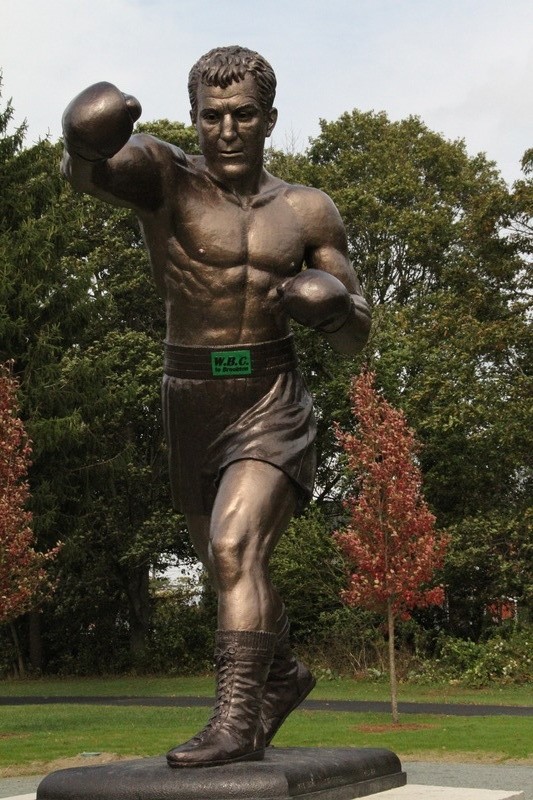
The Rocky Marciano statue, which sits outside Brockton High School, depicts the former heavyweight champion, a Brockton native who died in 1969.
After all the monies were tallied, Walcott received his career high purse of $250,000, while the champion’s share was $166,038.60.
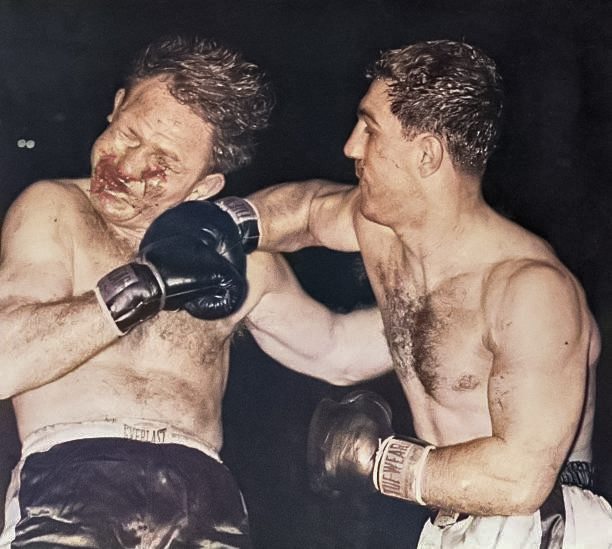
Rocky Marciano (R) brutally pounds contender Lee Savold (L) en route to stopping Savold in six rounds at the Philadelphia Convention Hall on February 13, 1952.
Not surprising, before the second Walcot fight, Marciano was the 16-5 betting favorite and an Associated Press poll saw 34 of 36 sportswriters picking Rocky to win.
After their epic first fight and devastating conclusion, it was apparent to all watching that Walcott came out in the rematch boxing cautiously, and even appeared somewhat gun shy. Apparently, Jersey Joe still must have had the lingering pains and whispering memory of the power of Rocky’s punches bouncing in his brain prior to the sound of the bell for the opening round. Marciano, on the other hand, was bobbing and weaving and aggressively throwing battering ram shots. The first round started off all for Marciano as Walcott safely jabbed and danced away. Suddenly, after the challenger threw a jab, Marciano quickly countered with a left hook and a right uppercut that lifted Jersey Joe off six inches off the canvas and deposited him on the seat of his pants where he was counted out for the full ten count at 2:25 of the opening round.
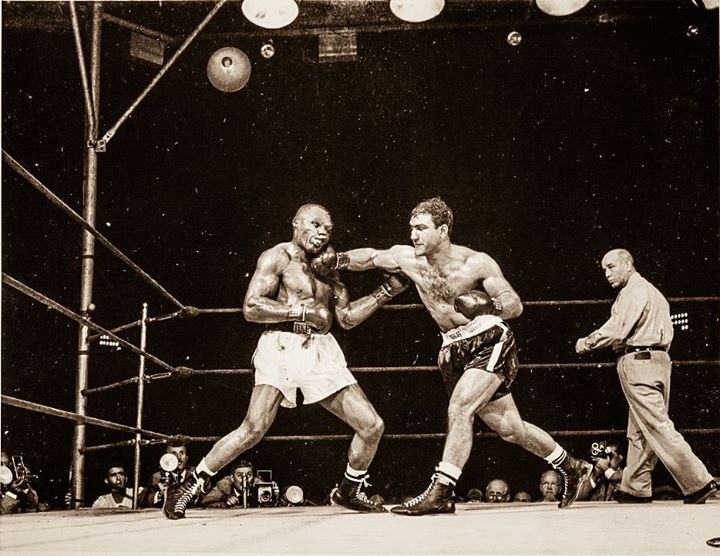
Jersey Joe Walcott receives KO blow from Rocky Marciano in their memorable first battle. (CLICKPHOTO TO SEE VIDEO OF THE FIGHT.)
After referee Frank Sikora tolled the fatal ten-count, Walcott did actually get up, but it was simply too little too late. Jersey Joe, like every other former champion before him, failed to regain his championship.
The Marciano-Walcott rematch was also the first championship fight to be filmed on the new 3D technique and would soon afterwards be shown in movie theaters in 3D, with viewers watching the bout with cardboard red and blue tinted 3D glasses on. Unfortunately for the theater audiences, they were treated to more training footage than actual fight action, thanks to the dynamite charge in Rocky Marciano’s right fist.
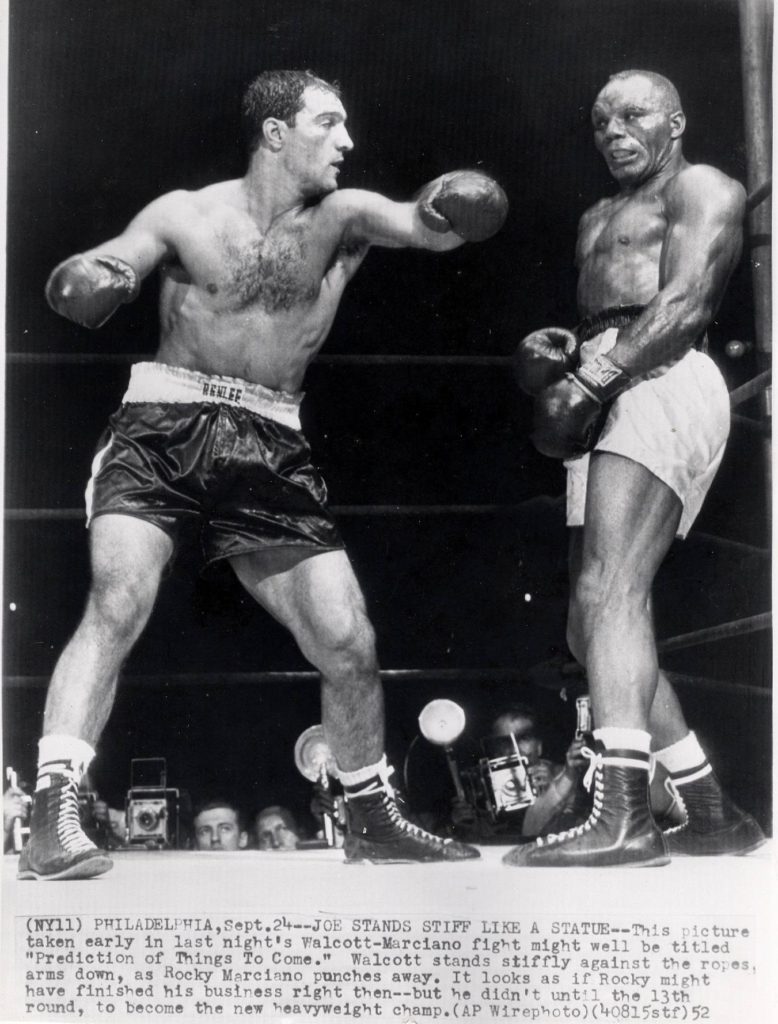
Jersey Joe Walcott pulls away from Rocky Marciano in their epic first battle, (CLICK PHOTO TO SEE VIDEO OF THE FIGHT WHEN WALCOTT APPEARED ON MARCIANO’S TELEVISION SHOW).
- Rocky Marciano – the Legend
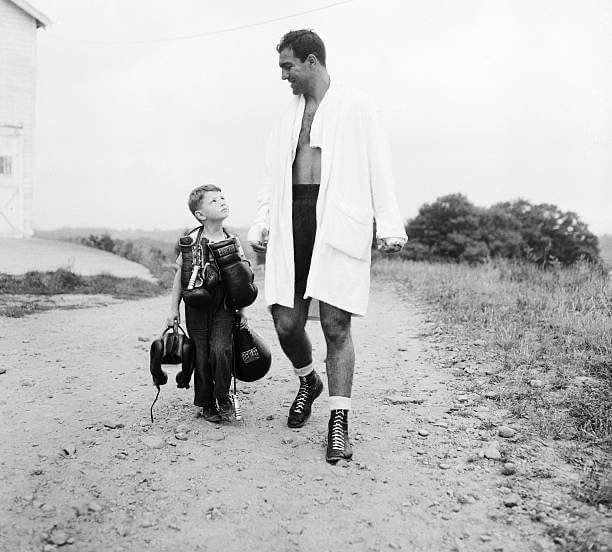
- Marciano was born in September 1923 in Brockton, Massachusetts to Italian immigrant parents. He grew up fighting with his siblings in the streets of Brockton, instilling an early toughness that would serve him well in the ring. As a rising amateur boxer during World War 2, Marciano balanced his boxing career with physically demanding labor jobs, including working in a shoe factory and on the docks, in order to support his family. This showed the unbreakable work ethic that would define his professional career.
- Though Rocky retired in 1956, his 49-0 record stands as boxing’s preeminent achievement, showcasing the heights attainable through perseverance and heart.
- Despite being smaller than most heavyweights, Marciano’s dedication, relentless training, and tough punches helped him compete and defeat the best in the division and would have served him well going into the 21st century.
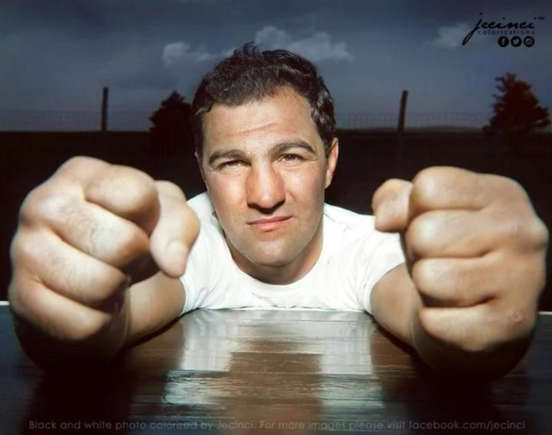
- Unlike many fighters who fight in spurts, Marciano’s unrelenting pace and destructiveness in the ring solidified his dominance as the heavyweight champion, with notable stoppage wins reinforcing his status as the unparalleled destroyer.
More than six decades have passed since Rocky Marciano, the Brockton-born “Rock,” last entered the ring, yet he remains one of boxing’s legends as well as one of the greatest sports icons of all-time. With a career record of 49-0, Marciano stands alone as the only heavyweight champion in history to retire undefeated. His remarkable story of overcoming adversity through grit and relentless punching power has transcended the sport.
 Rocky Marciano turned pro in 1947 at age 23. Right from the onset of his career, Rocky was dedicated to both boxing as well as to general conditioning. He would spend hours every day practicing new techniques in the gym along with punching. He kept busy fighting lots of matches too. Stories say he worked on quick, short punches to build power and tough hands, despite being smaller. This helped make up for his size. Even though some doubted him, Rocky’s never-give-up attitude helped him compete with, and eventually beat all the best heavyweights. Through tireless training, he proved size isn’t everything – heart and hard work can beat anything.
Rocky Marciano turned pro in 1947 at age 23. Right from the onset of his career, Rocky was dedicated to both boxing as well as to general conditioning. He would spend hours every day practicing new techniques in the gym along with punching. He kept busy fighting lots of matches too. Stories say he worked on quick, short punches to build power and tough hands, despite being smaller. This helped make up for his size. Even though some doubted him, Rocky’s never-give-up attitude helped him compete with, and eventually beat all the best heavyweights. Through tireless training, he proved size isn’t everything – heart and hard work can beat anything.
Rising Through the Ranks with unbelievable knockout power, Marciano systematically battered opponents with his unstoppable forward aggression. By 1951, he owned a 23-0 record with 21 knockouts. However, most experts still considered Marciano unproven against elite competition. To gain respect, Marciano would need to upset a legendary figure. That opportunity emerged against the great Joe Louis.
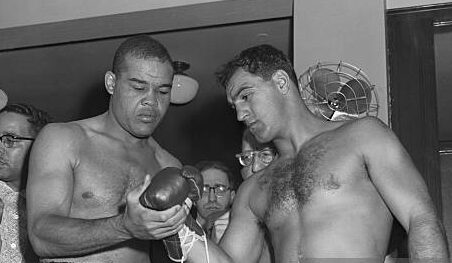
(Original Caption) Joe Louis 212 3/4 lbs; Rocky Marciano, 187, for Garden fight. Rocky Marciano feeling glove tried on by Louis.
In September 1951, the 37-year-old Louis seemed to on his way to earning another shot at the heavyweight title having won eight straight bouts, three of them coming by way of knockout. He was also still considered a national hero and was even favored to beat the younger Marciano. Rocky grew up idolizing “The Brown Bomber” and saw the bout as his ultimate proving ground. After absorbing an early barrage, Marciano’s pressure began breaking Louis down. A shuddering flurry in the 8th round deposited Louis on the canvas, punctuating Marciano’s stunning upset.
“I wish I could’ve gone longer to savor beating my idol,” Marciano said of his win over Joe Louis. “But I’ll always cherish that moment.”
The shocking win silenced both doubters and eventually positioned Marciano for a title shot against Jersey Joe Walcot, which he won via a devastating 13th round KO.
Over four years defending his throne, Marciano made six successful title retention bouts while showcasing peerless durability. Notable stoppage wins reinforced Marciano’s status as the division’s unparalleled destroyer.
By 1956, Marciano had prevailed over every top challenger as crowds flocked to witness “The Rock’s” destructive genius firsthand.
Trainer Charley Goldman would time Marciano punching the heavy bag. At his peak, Marciano threw over 125 punches in just one minute. “I’ve never seen power like that generated so swiftly,” Goldman said. This unrelenting pace broke down foes. Challenger Roland LaStarza noted Marciano “came at you like a non-stop buzz saw. You couldn’t take a breath.”
At his physical and mental peak still only age 32, Marciano opted to retire to the chagrin of boxing fans throughout the world. Following a clinical first-round beating of Archie Moore in September 1956, Marciano exited between the ropes as heavyweight boxing’s sole undefeated champion.
Over six decades later, Marciano’s pristine 49-0-mark looms as the sport’s preeminent achievement, a symbol of the heights attainable through perseverance and heart.
Sadly, at only 46 years old, Rocky had accomplished everything he set out to do in the ring. But sadly, his remarkable journey was cut tragically short.
On August 31, 1969, Rocky boarded a small four-seat plane in Chicago heading to Florida. With him were the pilot, Frank Palermo, and another passenger. Bad weather moved in as they flew over Iowa that night. Around midnight near Newton, Palermo tried making an emergency landing in a field nearby. As bad luck would have it, the plane struck the only tree in the hundreds of acres of cornfields.
The investigation found Palermo, who was 70, likely got confused in the dark storm. Also, the small plane was over 2,000 pounds too heavy for the three men. It didn’t have the right paperwork either for flying in bad conditions.
Unfortunately, in the pounding rain with zero visibility, the plane crashed into a lone tree in the field. Everyone on board, including the legendary Rocky, passed away on impact.
The sudden loss of “The Rock” was a big shock to boxing. Even big fighters like Muhammad Ali said they were sad about the tragedy. Rocky had achieved so much in his short life and career, only for it to end in a preventable accident at only 46 years old.
Nearly six decades later, Rocky Marciano and his legend still casts a large and permanent shadow as one of the sport’s true immortals. Marciano gave us a legacy that perseveres despite his untimely departure, a fitting final statement from one of boxing’s greatest sons.

CLICK PICTURE TO VIEW VIDEO OF : 5 Times Rocky Marciano Looked Invincible
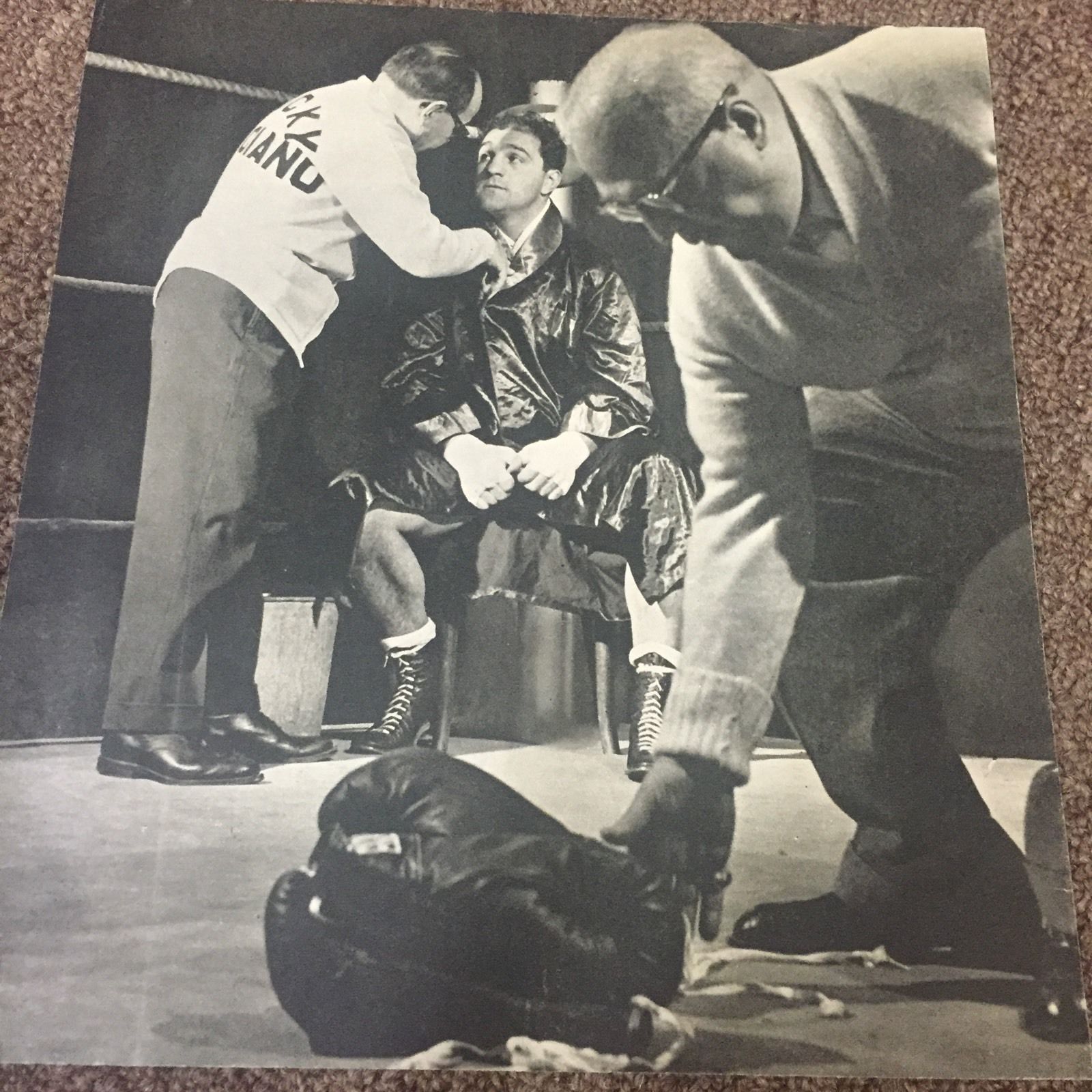
Rocky Marciano Ring Corner Photo. CLICK PICTURE TO SEE VIDEO OF : Hardest Punchers in Boxing – Rocky MARCIANO Knockouts & Highlights – Symphony of Destruction
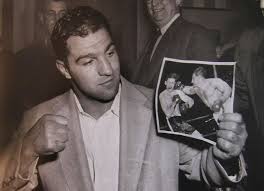
Rocky Marciano striking a boxing pose while holding a photo of his recent bout (CLICK PHOTO to view “The Bull” A Tribute To Rocky Marciano. This starts off with a great quote by Ali.)
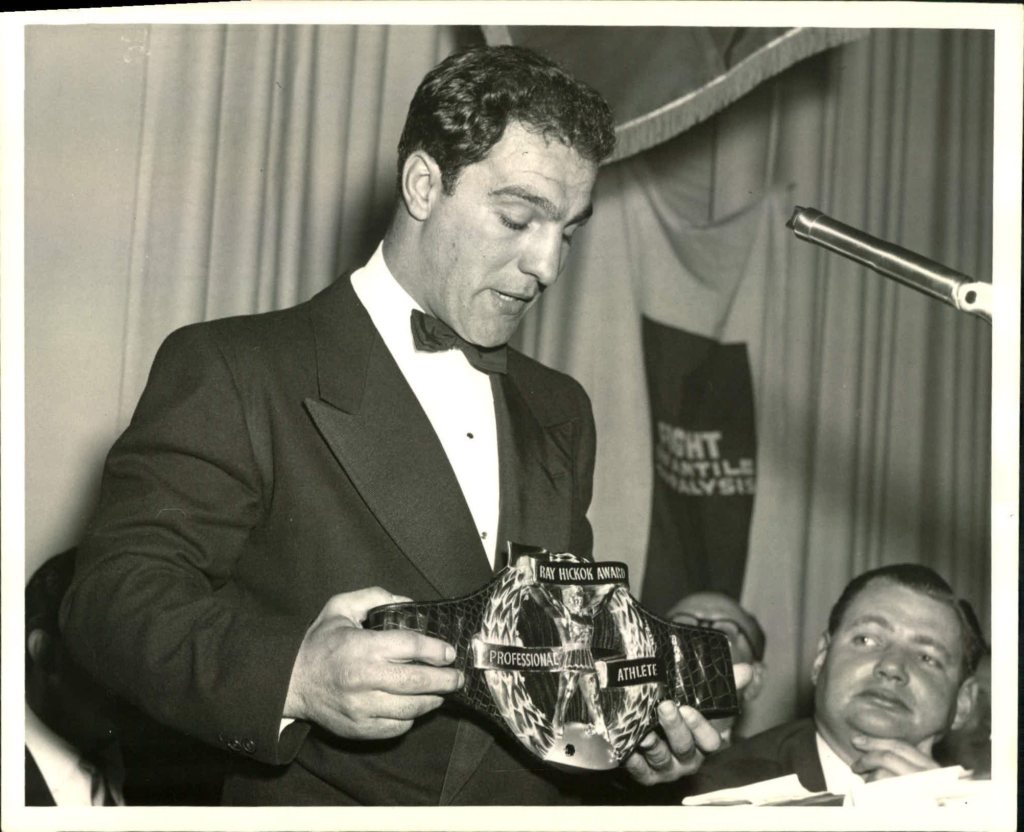
Rocky Marciano being awarded the prestigious Hickok Belt (CLICK PHOTO to view No Easy Way Out : Rocky Marciano Tribute)
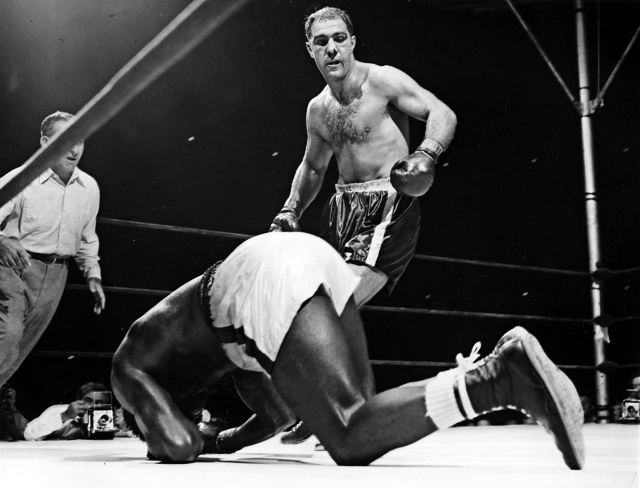
Rocky Marciano knocking out Ezzard Charles in their second fight. (CLICK PHOTO to view Rocky Meets Our Heavies from 1965)
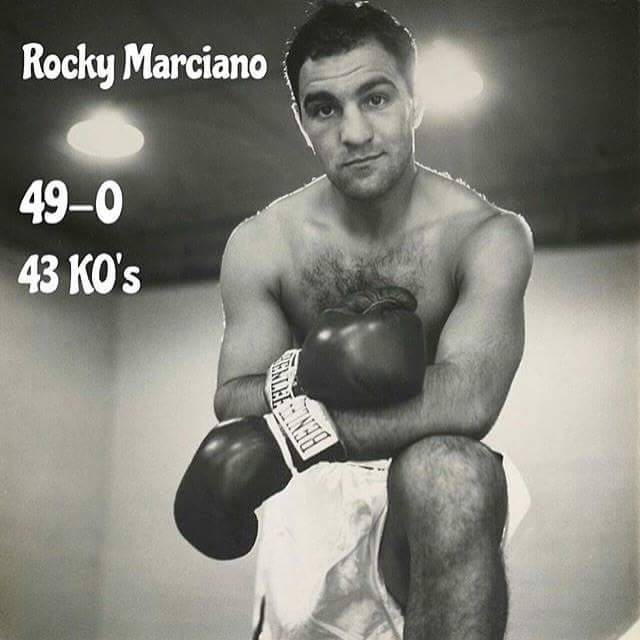
The legendary Rocky Marciano (CLICK ON PHOTO to view Rocky’s knockouts and hear the Rock Group Metallica sing For Whom the Bell Tolls with lyrics)
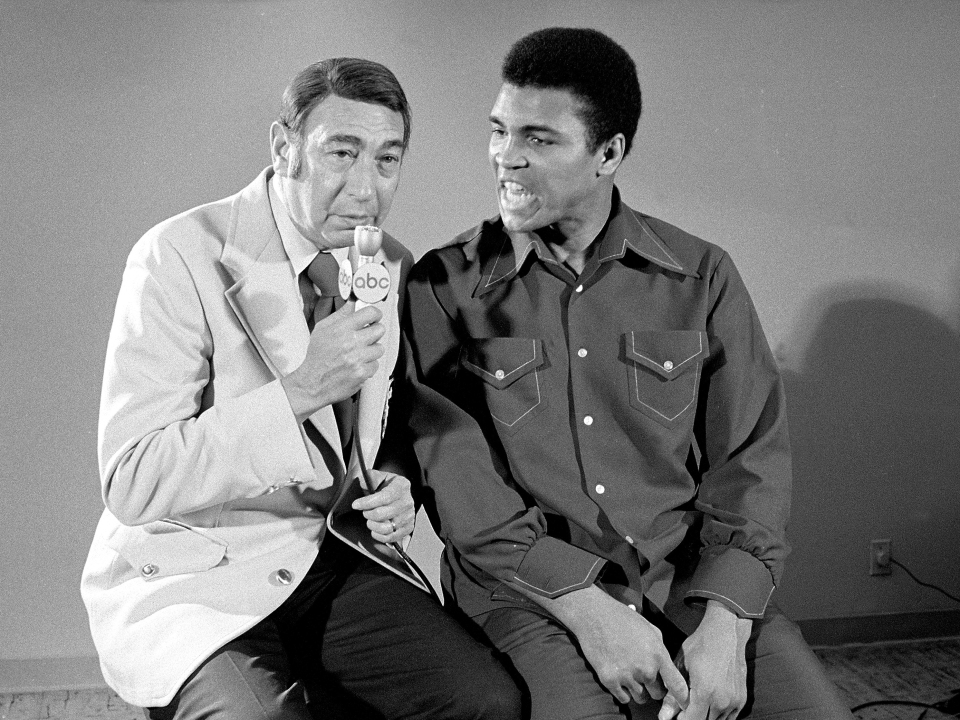
Muhammad Ali with ABC Sports announcer Howard Cosell talking about Rocky Marciano during an interview at Caesars Palace Hotel. (CLICK ON PHOTO TO SEE HOWARD COSELL INTERVIEWING MUHAMMAD ALI BOUT ROCKY MARCIANO)
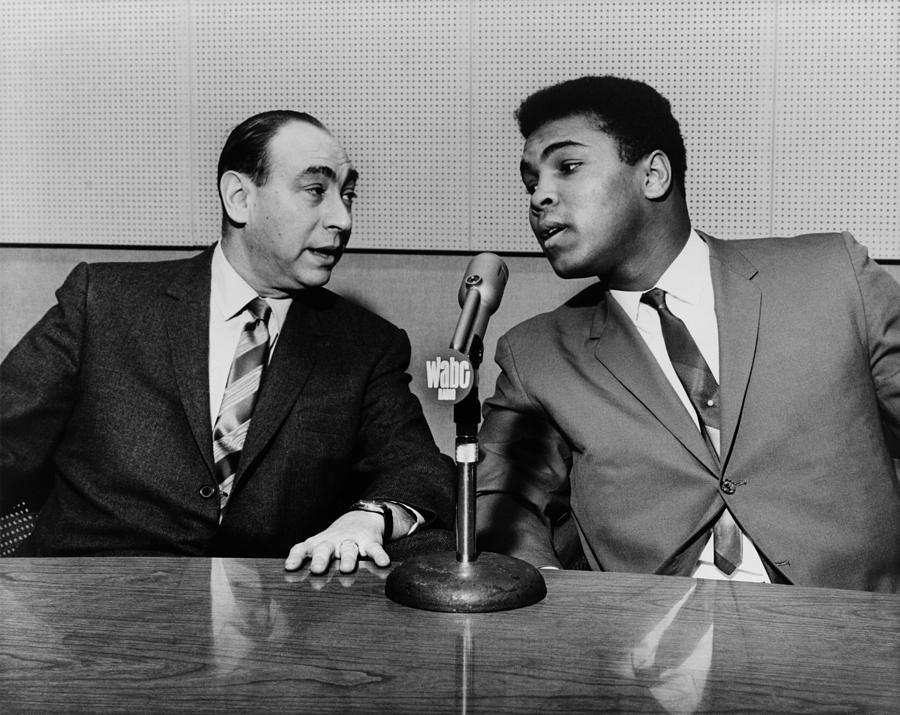
Muhammad Ali with ABC Sports announcer Howard Cosell talking about Rocky Marciano (CLICK ON PHOTO TO HEAR MUHAMMAD ALI TALK ABOUT ROCKY MARCIANO)
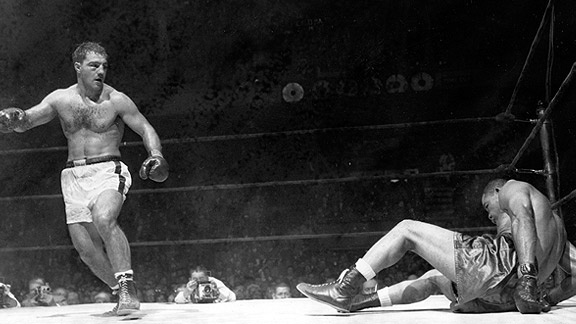
Rocky Marciano dropping Joe Louis to canvas in their October 26, 1950 bout in Madison Square Garden. Marciano won by TKO in round 8.
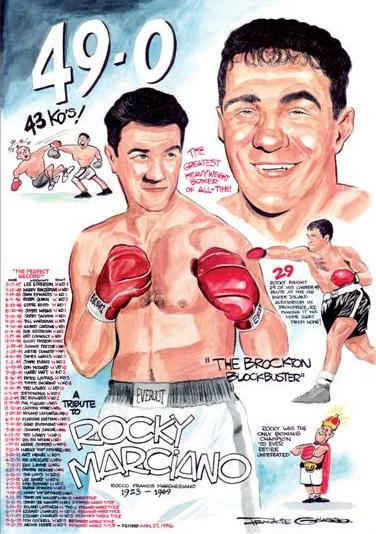
Rocky Marciano’s perfect record. (CLICK ON PHOTO TO VIEW DOCUMENTARY OF ROCKY FEATURING GEORGE FOREMAN, LOU DUVA, TEDDY ATLAS, AND BERT SUGAR)
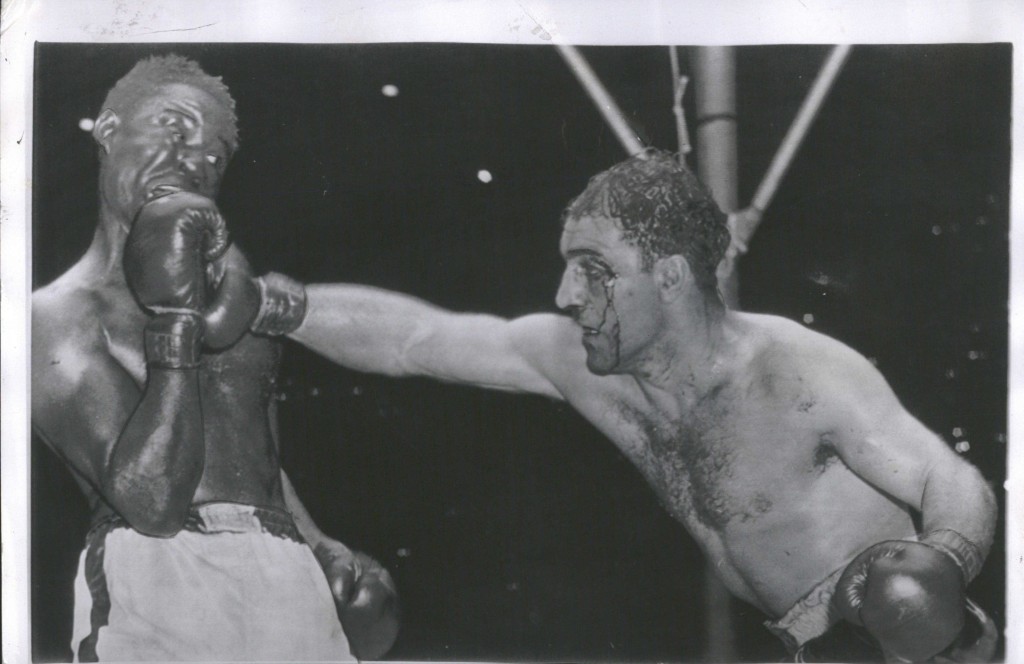
Marciano landing a hard right against Ezzard Charles in their first bout June 16, 1954 in Yankee Stadium.
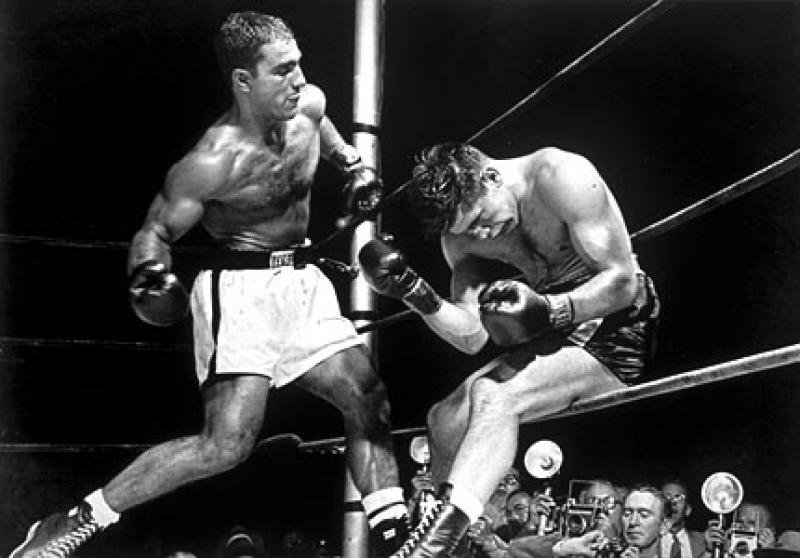
Rocky Marciano knocking out challenger Roland La Starza in round 11 at the Polo Grounds in NY on September 24, 1953. (CLICK PHOTO TO VIEW PART 1 OF CELEBRITY TRIBUTE TO ROCKY MARCIANO)
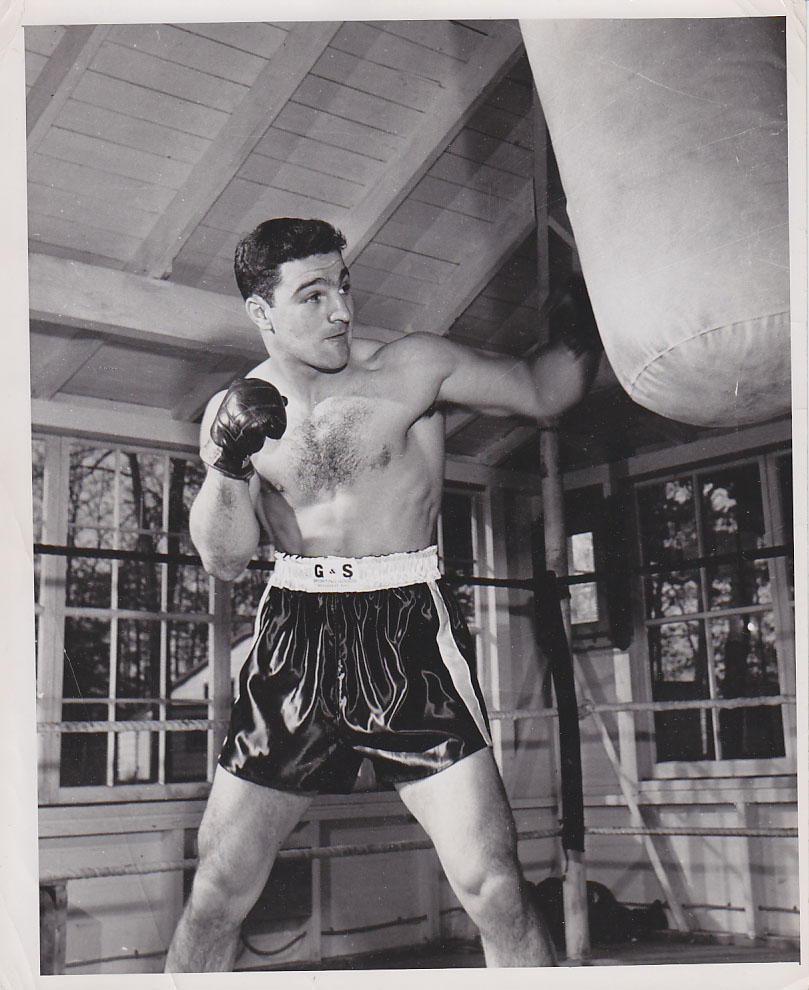
Young challenger Rocky Marciano pounding the heavy bag in training. (CLICK PHOTO TO VIEW PART 2 OF CELEBRITY TRIBUTE TO ROCKY MARCIANO)
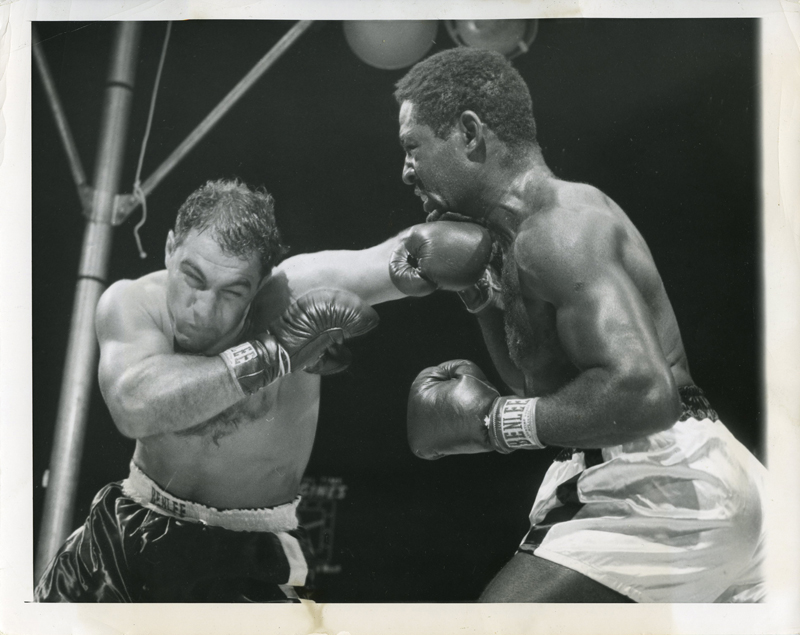
Rocky Marciano and Ezzard Charles trading leather in 1954 in Yankee Stadium. (CLICK PHOTO TO VIEW PART 3 OF CELEBRITY TRIBUTE TO ROCKY MARCIANO)
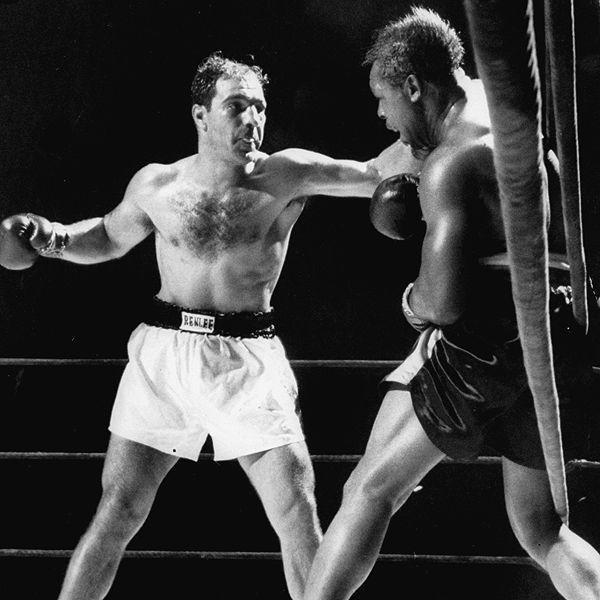
Rocky Marciano setting challenger Archie Moore up for the kill in their bout on September 21, 1955 at Yankee Stadium in NY on September 24, 1953. (CLICK PHOTO TO VIEW PART 4 OF CELEBRITY TRIBUTE TO ROCKY MARCIANO)
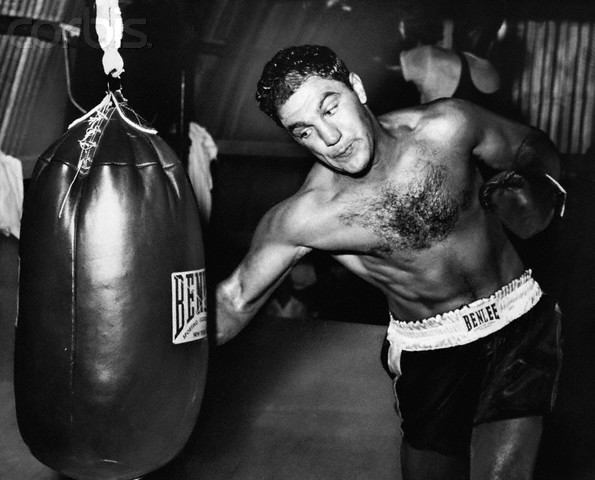
18 Aug 1955, Grossinger, New York, USA — 8/18/1955- Grossinger, NY: Solid defender. World heavyweight champion Rocky Marciano gets in some licks with the big bag while training here for his forthcoming bout with Archie Moore. Marciano will defend his title against the light heavyweight champion September 20th at Yankee Stadium.
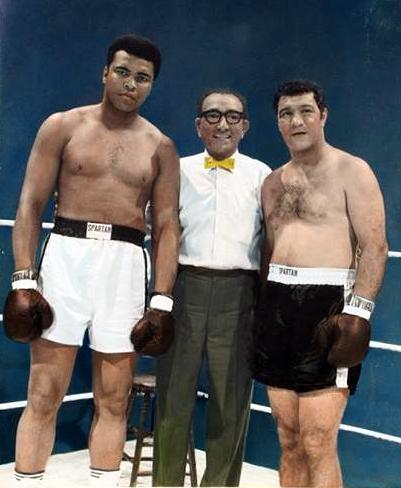
Muhammad Ali and Rocky Marciano during the making of their Super fight in 1969 when Marciano was 46 years old. (CLICK VIDEO TO SEE PREVIEW/TRAILER OF THE SUPER FIGHT)
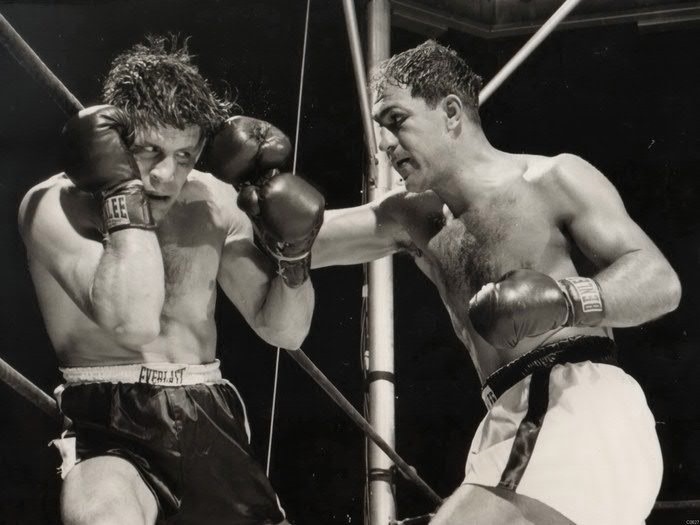
Rocky Marciano (R) attacking challenger Roland La Starza (L) in their 1953 Heavyweight Championship Battle
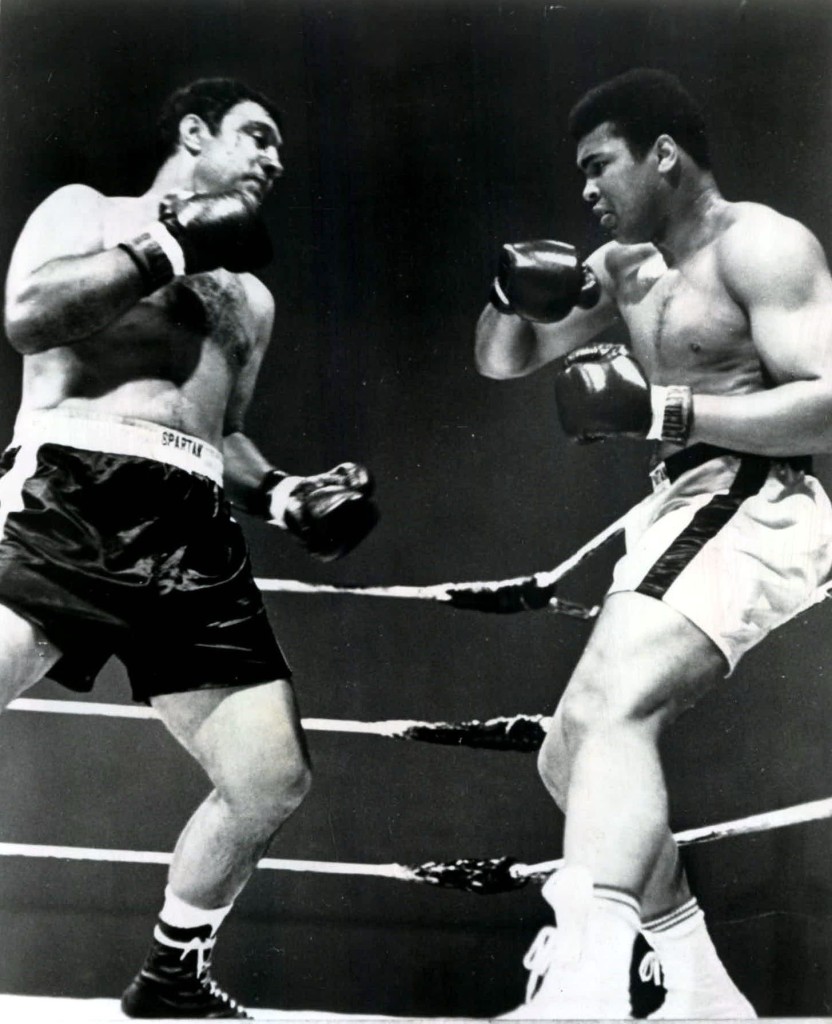
Rocky Marciano charging Muhammad Ali in their classic computer super fight (CLICK ON PHOTO TO SEE HIGHLIGHTS OF THE FAMOUS AND LEGENDARY BOUT)
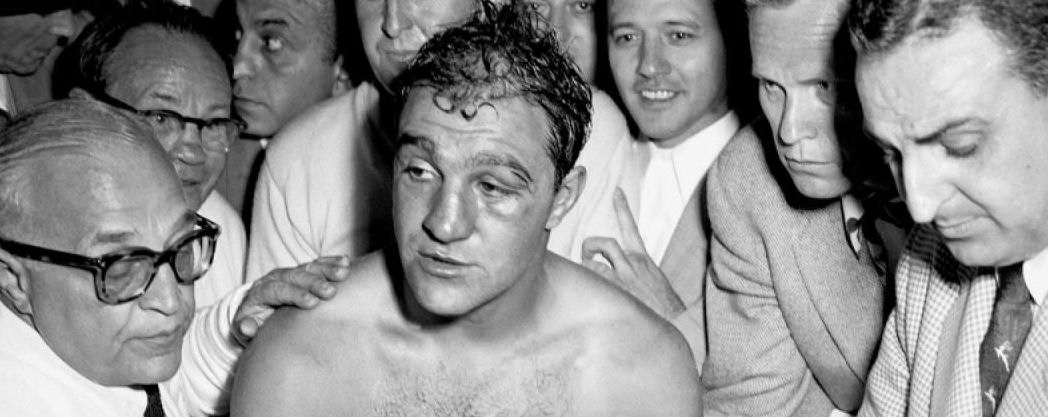
Manager Al Weil and Rocky Marciano after capturing the heavyweight title from Jersey Joe Walcott September 23, 1952 via KO in round 13 at Municipal stadium in Philadelphia, PA.
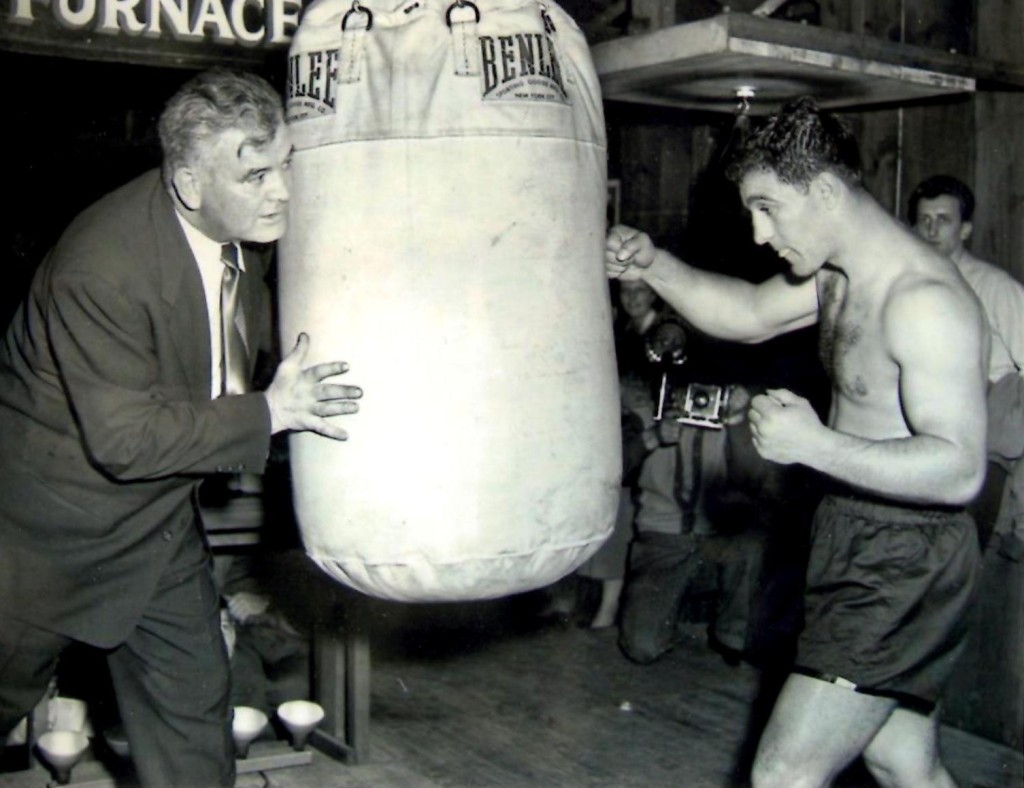
Former Heavyweight Champion James J. Braddock with heavyweight Challenger Rocky Marciano in training.
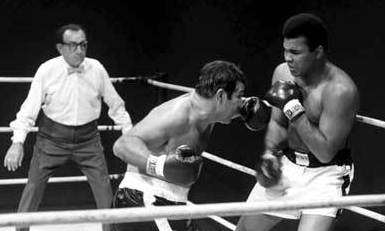
Rocky Marciano vs. Muhammad Ali in their Super Fight. (CLICK ON PHOTO TO SEE HIGHLIGHTS OF THE HISTORIC BOUT)
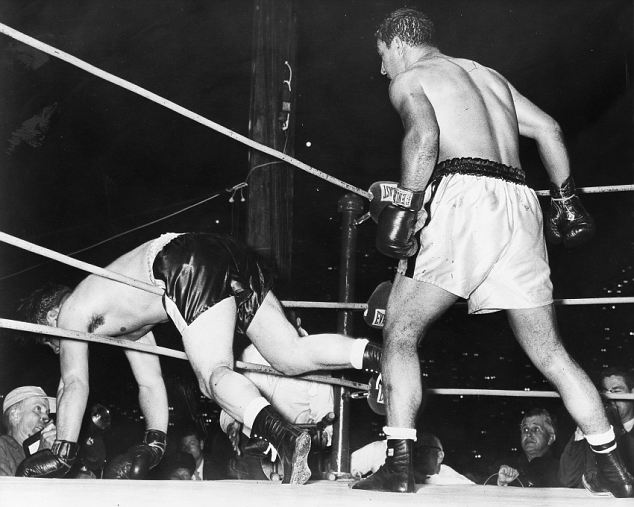
A long right to the chin from Marciano in round eight leaves Cockell draped through the ropes. The champion holds off on this occasion, waiting to see if his opponent will recover. 16 May 1955 (CLICK PHOTO TO VIEW VIDEO OF FIGHT)
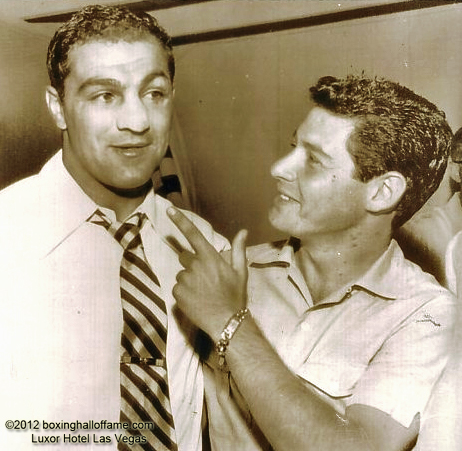
Rocky Marciano and his dear friend singer Eddie Fisher after his second bout with Ezzard Charles in 1954.
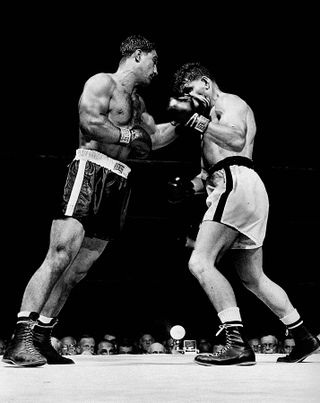
Rocky Marciano (L) knocking out top contender Rex Layne in the 6th round in Madison Square Garden on July 12, 1951.
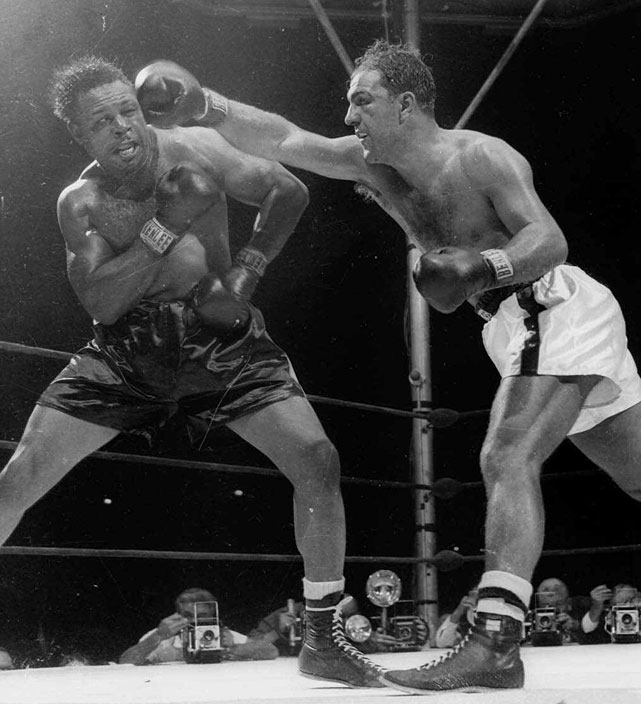
Rocky Marciano (R) stabbing Archie Moore with a hard right in their September 21, 1955 bout at Yankee Stadium where Marciano won by a 9th round knockout.
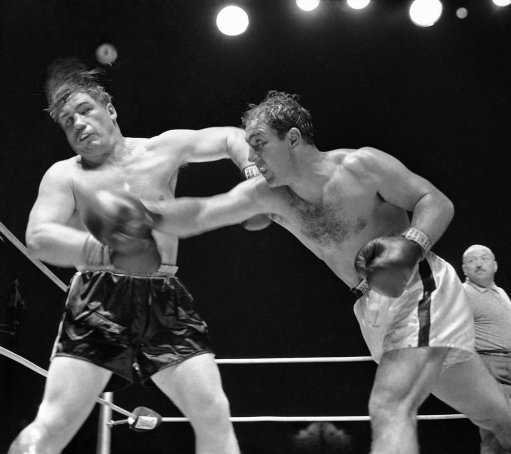
Rocky Marciano, heavyweight champion from Brockton, Mass., rocks challenger Don Cockell with a wicked right in the ninth round of their title bout at Kezar Stadium in San Francisco, Calif., May 16, 1955. Rocky kept his title via a TKO when the referee stopped the bout after 54 seconds of the ninth round.
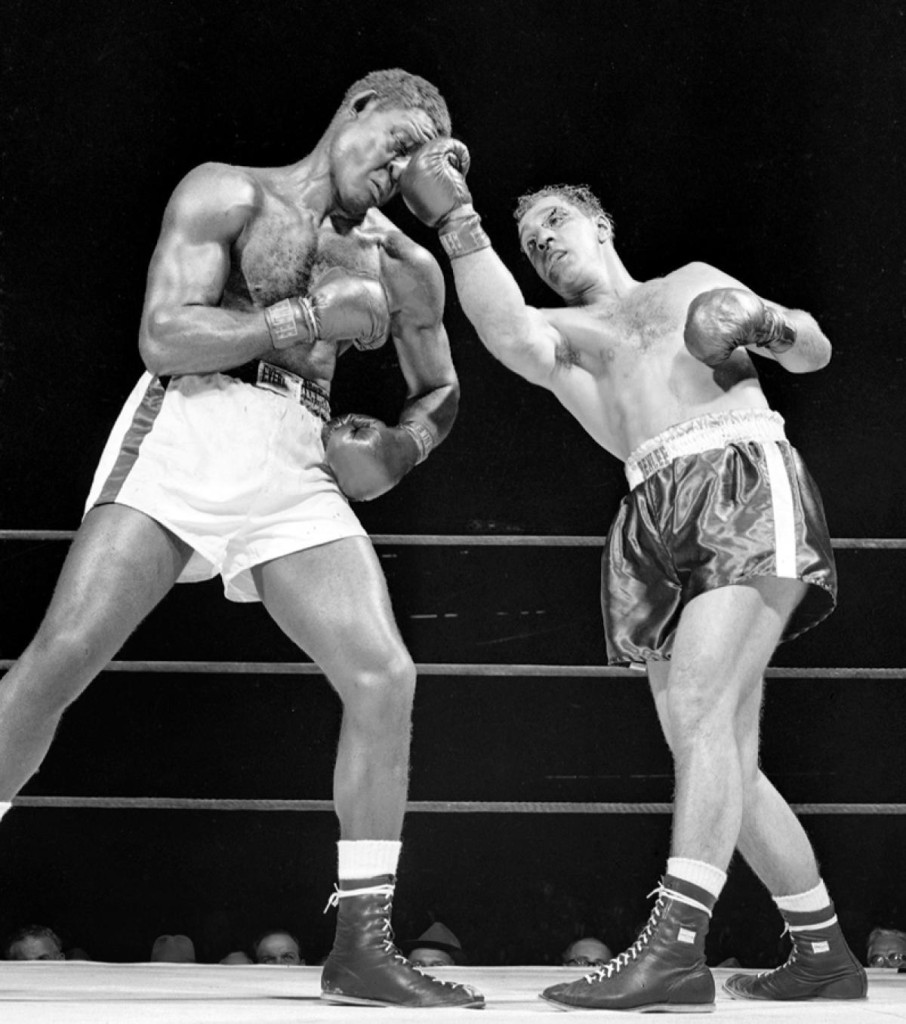
Rocky Marciano and Ezzard Charles in their June 17, 1954 bout in Yankee Stadium. (CLICK ON PHOTO TO VIEW FIGHT CLIP)
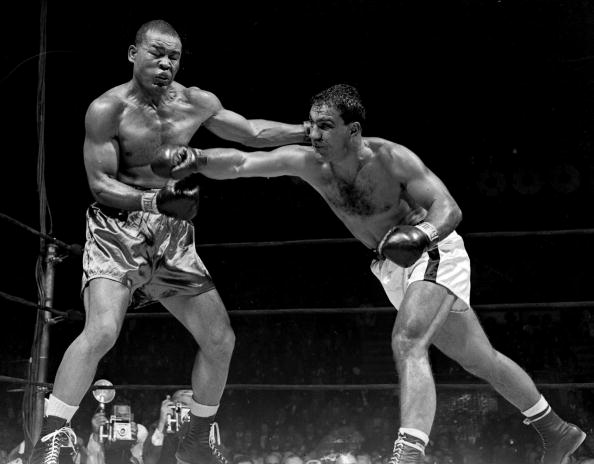
Rocky Marciano’s eyes glint confidently after he drives a tremendous right to jaw that practically paralyzes Joe Louis in the eighth round at Garden last night.
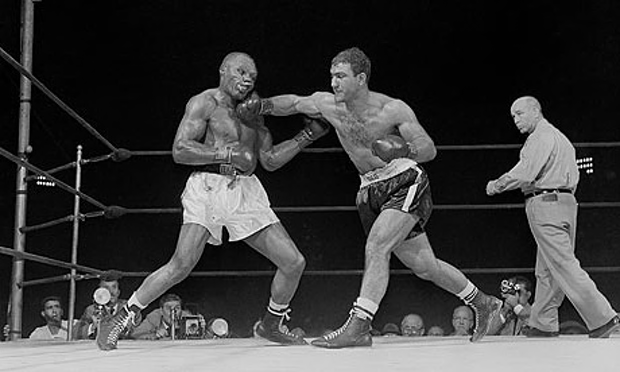
Rocky Marciano landing the crucial knockout punch on Jersey Joe Walcott in their 1952 title bout that Marciano won by knockout in the 13th round. (CLICK ON PHOTO TO SEE CLIP FROM THE FIGHT)
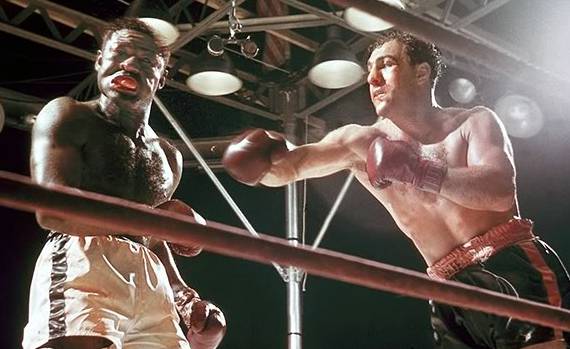
Rocky Marciano (R) smashing Ezzard Charles with a hard right in their first bout on September 17, 1954 at Yankee Stadium that Marciano won by unanimous decision.


